Hotel and IT decision-maker characteristics and information technology adoption relationship in the hotel industry
VerifiedAdded on 2022/11/25
|14
|8289
|148
AI Summary
This paper examines the impact of hotel property characteristics and IT decision-maker characteristics on RFID technology adoption in the US hotel industry. The study found that larger hotels and hotels that are part of a franchise are more likely to adopt RFID technology. In addition, IT decision-makers who are young, with high level of education and with shorter job tenure are more likely to adopt RFID technology.
Contribute Materials
Your contribution can guide someone’s learning journey. Share your
documents today.
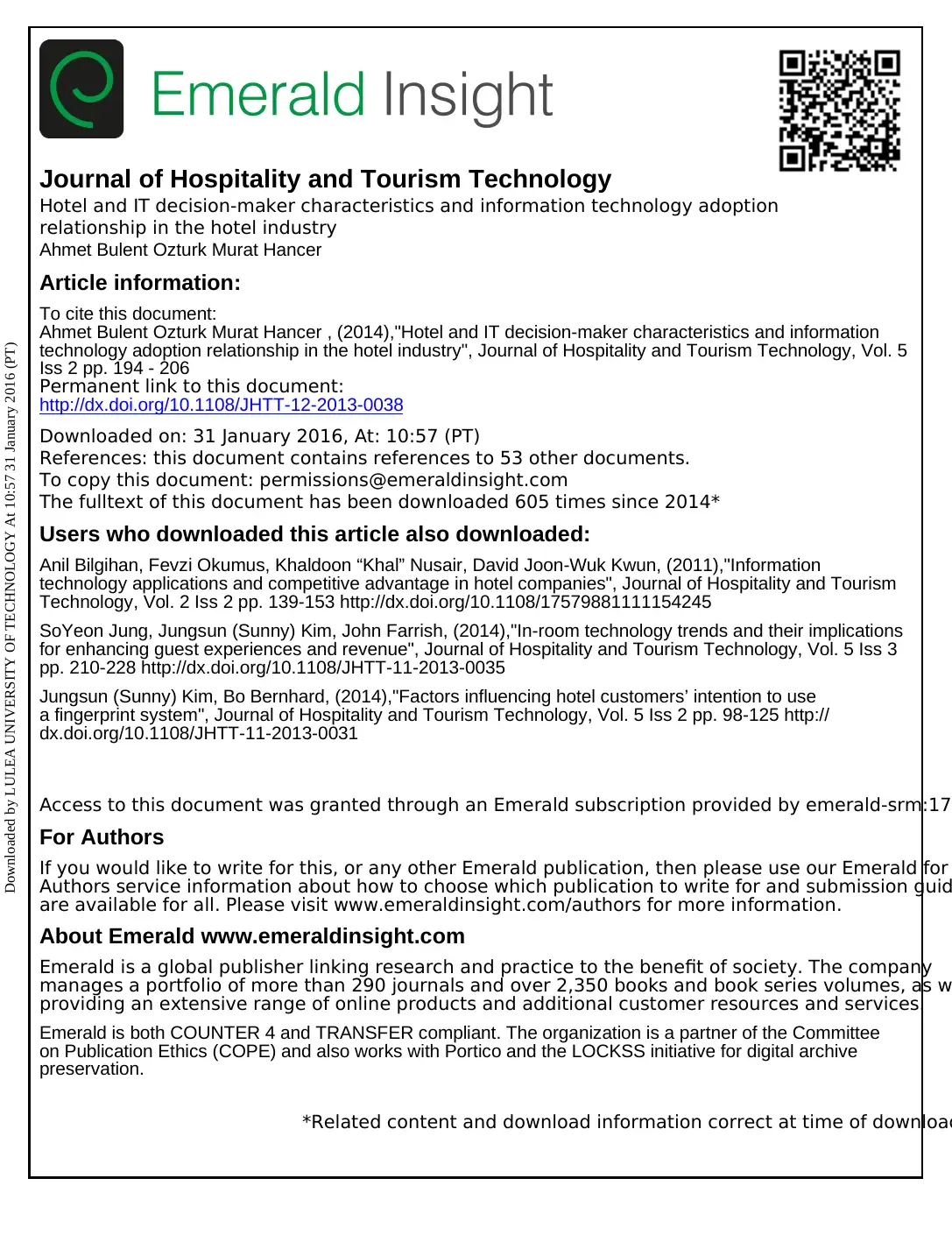
Journal of Hospitality and Tourism Technology
Hotel and IT decision-maker characteristics and information technology adoption
relationship in the hotel industry
Ahmet Bulent Ozturk Murat Hancer
Article information:
To cite this document:
Ahmet Bulent Ozturk Murat Hancer , (2014),"Hotel and IT decision-maker characteristics and information
technology adoption relationship in the hotel industry", Journal of Hospitality and Tourism Technology, Vol. 5
Iss 2 pp. 194 - 206
Permanent link to this document:
http://dx.doi.org/10.1108/JHTT-12-2013-0038
Downloaded on: 31 January 2016, At: 10:57 (PT)
References: this document contains references to 53 other documents.
To copy this document: permissions@emeraldinsight.com
The fulltext of this document has been downloaded 605 times since 2014*
Users who downloaded this article also downloaded:
Anil Bilgihan, Fevzi Okumus, Khaldoon “Khal” Nusair, David Joon-Wuk Kwun, (2011),"Information
technology applications and competitive advantage in hotel companies", Journal of Hospitality and Tourism
Technology, Vol. 2 Iss 2 pp. 139-153 http://dx.doi.org/10.1108/17579881111154245
SoYeon Jung, Jungsun (Sunny) Kim, John Farrish, (2014),"In-room technology trends and their implications
for enhancing guest experiences and revenue", Journal of Hospitality and Tourism Technology, Vol. 5 Iss 3
pp. 210-228 http://dx.doi.org/10.1108/JHTT-11-2013-0035
Jungsun (Sunny) Kim, Bo Bernhard, (2014),"Factors influencing hotel customers’ intention to use
a fingerprint system", Journal of Hospitality and Tourism Technology, Vol. 5 Iss 2 pp. 98-125 http://
dx.doi.org/10.1108/JHTT-11-2013-0031
Access to this document was granted through an Emerald subscription provided by emerald-srm:17
For Authors
If you would like to write for this, or any other Emerald publication, then please use our Emerald for
Authors service information about how to choose which publication to write for and submission guid
are available for all. Please visit www.emeraldinsight.com/authors for more information.
About Emerald www.emeraldinsight.com
Emerald is a global publisher linking research and practice to the benefit of society. The company
manages a portfolio of more than 290 journals and over 2,350 books and book series volumes, as w
providing an extensive range of online products and additional customer resources and services.
Emerald is both COUNTER 4 and TRANSFER compliant. The organization is a partner of the Committee
on Publication Ethics (COPE) and also works with Portico and the LOCKSS initiative for digital archive
preservation.
*Related content and download information correct at time of download
Downloaded by LULEA UNIVERSITY OF TECHNOLOGY At 10:57 31 January 2016 (PT)
Hotel and IT decision-maker characteristics and information technology adoption
relationship in the hotel industry
Ahmet Bulent Ozturk Murat Hancer
Article information:
To cite this document:
Ahmet Bulent Ozturk Murat Hancer , (2014),"Hotel and IT decision-maker characteristics and information
technology adoption relationship in the hotel industry", Journal of Hospitality and Tourism Technology, Vol. 5
Iss 2 pp. 194 - 206
Permanent link to this document:
http://dx.doi.org/10.1108/JHTT-12-2013-0038
Downloaded on: 31 January 2016, At: 10:57 (PT)
References: this document contains references to 53 other documents.
To copy this document: permissions@emeraldinsight.com
The fulltext of this document has been downloaded 605 times since 2014*
Users who downloaded this article also downloaded:
Anil Bilgihan, Fevzi Okumus, Khaldoon “Khal” Nusair, David Joon-Wuk Kwun, (2011),"Information
technology applications and competitive advantage in hotel companies", Journal of Hospitality and Tourism
Technology, Vol. 2 Iss 2 pp. 139-153 http://dx.doi.org/10.1108/17579881111154245
SoYeon Jung, Jungsun (Sunny) Kim, John Farrish, (2014),"In-room technology trends and their implications
for enhancing guest experiences and revenue", Journal of Hospitality and Tourism Technology, Vol. 5 Iss 3
pp. 210-228 http://dx.doi.org/10.1108/JHTT-11-2013-0035
Jungsun (Sunny) Kim, Bo Bernhard, (2014),"Factors influencing hotel customers’ intention to use
a fingerprint system", Journal of Hospitality and Tourism Technology, Vol. 5 Iss 2 pp. 98-125 http://
dx.doi.org/10.1108/JHTT-11-2013-0031
Access to this document was granted through an Emerald subscription provided by emerald-srm:17
For Authors
If you would like to write for this, or any other Emerald publication, then please use our Emerald for
Authors service information about how to choose which publication to write for and submission guid
are available for all. Please visit www.emeraldinsight.com/authors for more information.
About Emerald www.emeraldinsight.com
Emerald is a global publisher linking research and practice to the benefit of society. The company
manages a portfolio of more than 290 journals and over 2,350 books and book series volumes, as w
providing an extensive range of online products and additional customer resources and services.
Emerald is both COUNTER 4 and TRANSFER compliant. The organization is a partner of the Committee
on Publication Ethics (COPE) and also works with Portico and the LOCKSS initiative for digital archive
preservation.
*Related content and download information correct at time of download
Downloaded by LULEA UNIVERSITY OF TECHNOLOGY At 10:57 31 January 2016 (PT)
Secure Best Marks with AI Grader
Need help grading? Try our AI Grader for instant feedback on your assignments.
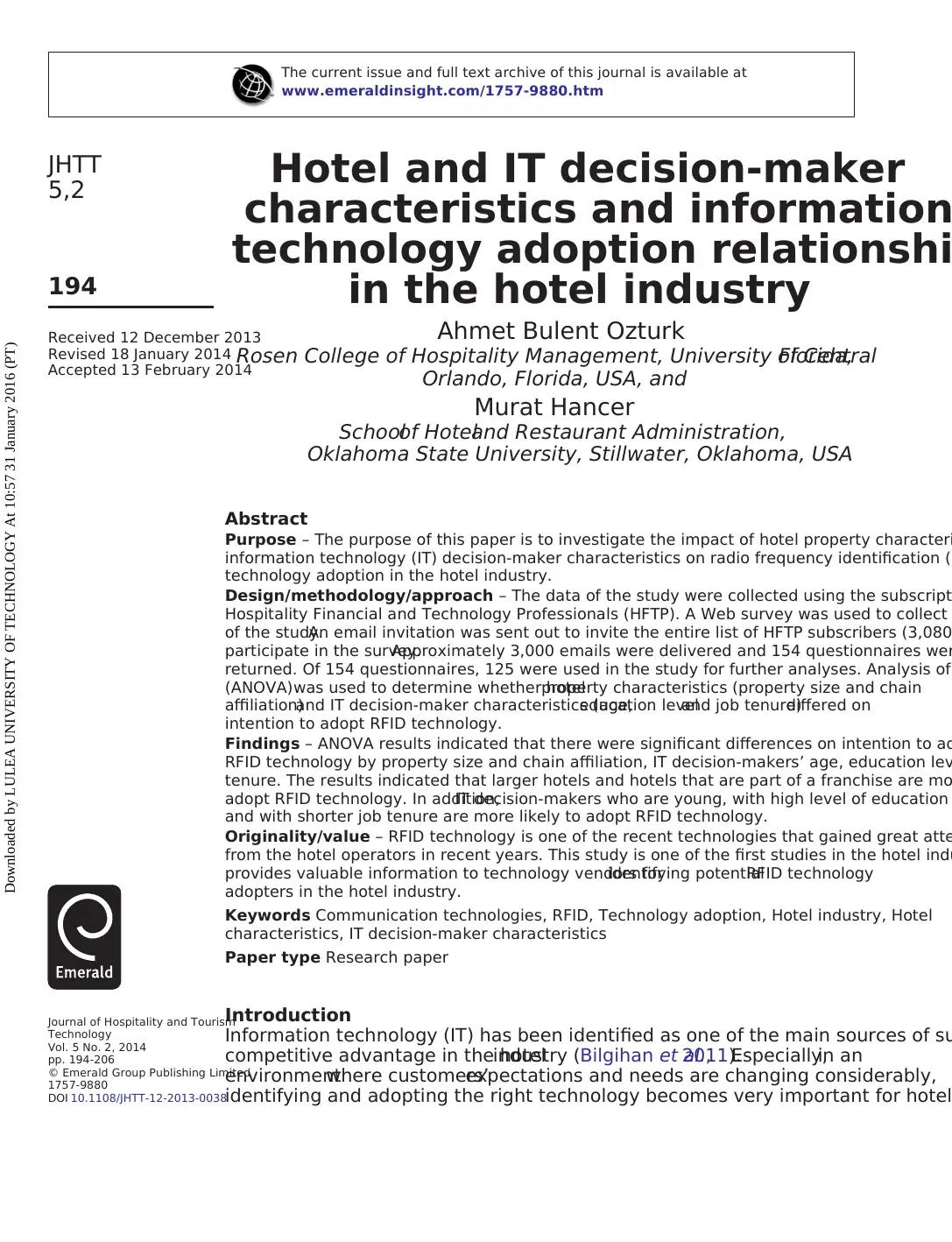
Hotel and IT decision-maker
characteristics and information
technology adoption relationshi
in the hotel industry
Ahmet Bulent Ozturk
Rosen College of Hospitality Management, University of CentralFlorida,
Orlando, Florida, USA, and
Murat Hancer
Schoolof Hoteland Restaurant Administration,
Oklahoma State University, Stillwater, Oklahoma, USA
Abstract
Purpose – The purpose of this paper is to investigate the impact of hotel property characteri
information technology (IT) decision-maker characteristics on radio frequency identification (R
technology adoption in the hotel industry.
Design/methodology/approach – The data of the study were collected using the subscript
Hospitality Financial and Technology Professionals (HFTP). A Web survey was used to collect
of the study.An email invitation was sent out to invite the entire list of HFTP subscribers (3,080
participate in the survey.Approximately 3,000 emails were delivered and 154 questionnaires wer
returned. Of 154 questionnaires, 125 were used in the study for further analyses. Analysis of
(ANOVA)was used to determine whether hotelproperty characteristics (property size and chain
affiliation)and IT decision-maker characteristics (age,education leveland job tenure)differed on
intention to adopt RFID technology.
Findings – ANOVA results indicated that there were significant differences on intention to ad
RFID technology by property size and chain affiliation, IT decision-makers’ age, education lev
tenure. The results indicated that larger hotels and hotels that are part of a franchise are mo
adopt RFID technology. In addition,IT decision-makers who are young, with high level of education
and with shorter job tenure are more likely to adopt RFID technology.
Originality/value – RFID technology is one of the recent technologies that gained great atte
from the hotel operators in recent years. This study is one of the first studies in the hotel indu
provides valuable information to technology vendors foridentifying potentialRFID technology
adopters in the hotel industry.
Keywords Communication technologies, RFID, Technology adoption, Hotel industry, Hotel
characteristics, IT decision-maker characteristics
Paper type Research paper
Introduction
Information technology (IT) has been identified as one of the main sources of su
competitive advantage in the hotelindustry (Bilgihan et al.,2011).Especially,in an
environmentwhere customers’expectations and needs are changing considerably,
identifying and adopting the right technology becomes very important for hotel
The current issue and full text archive of this journal is available at
www.emeraldinsight.com/1757-9880.htm
JHTT
5,2
194
Received 12 December 2013
Revised 18 January 2014
Accepted 13 February 2014
Journal of Hospitality and Tourism
Technology
Vol. 5 No. 2, 2014
pp. 194-206
© Emerald Group Publishing Limited
1757-9880
DOI 10.1108/JHTT-12-2013-0038
Downloaded by LULEA UNIVERSITY OF TECHNOLOGY At 10:57 31 January 2016 (PT)
characteristics and information
technology adoption relationshi
in the hotel industry
Ahmet Bulent Ozturk
Rosen College of Hospitality Management, University of CentralFlorida,
Orlando, Florida, USA, and
Murat Hancer
Schoolof Hoteland Restaurant Administration,
Oklahoma State University, Stillwater, Oklahoma, USA
Abstract
Purpose – The purpose of this paper is to investigate the impact of hotel property characteri
information technology (IT) decision-maker characteristics on radio frequency identification (R
technology adoption in the hotel industry.
Design/methodology/approach – The data of the study were collected using the subscript
Hospitality Financial and Technology Professionals (HFTP). A Web survey was used to collect
of the study.An email invitation was sent out to invite the entire list of HFTP subscribers (3,080
participate in the survey.Approximately 3,000 emails were delivered and 154 questionnaires wer
returned. Of 154 questionnaires, 125 were used in the study for further analyses. Analysis of
(ANOVA)was used to determine whether hotelproperty characteristics (property size and chain
affiliation)and IT decision-maker characteristics (age,education leveland job tenure)differed on
intention to adopt RFID technology.
Findings – ANOVA results indicated that there were significant differences on intention to ad
RFID technology by property size and chain affiliation, IT decision-makers’ age, education lev
tenure. The results indicated that larger hotels and hotels that are part of a franchise are mo
adopt RFID technology. In addition,IT decision-makers who are young, with high level of education
and with shorter job tenure are more likely to adopt RFID technology.
Originality/value – RFID technology is one of the recent technologies that gained great atte
from the hotel operators in recent years. This study is one of the first studies in the hotel indu
provides valuable information to technology vendors foridentifying potentialRFID technology
adopters in the hotel industry.
Keywords Communication technologies, RFID, Technology adoption, Hotel industry, Hotel
characteristics, IT decision-maker characteristics
Paper type Research paper
Introduction
Information technology (IT) has been identified as one of the main sources of su
competitive advantage in the hotelindustry (Bilgihan et al.,2011).Especially,in an
environmentwhere customers’expectations and needs are changing considerably,
identifying and adopting the right technology becomes very important for hotel
The current issue and full text archive of this journal is available at
www.emeraldinsight.com/1757-9880.htm
JHTT
5,2
194
Received 12 December 2013
Revised 18 January 2014
Accepted 13 February 2014
Journal of Hospitality and Tourism
Technology
Vol. 5 No. 2, 2014
pp. 194-206
© Emerald Group Publishing Limited
1757-9880
DOI 10.1108/JHTT-12-2013-0038
Downloaded by LULEA UNIVERSITY OF TECHNOLOGY At 10:57 31 January 2016 (PT)
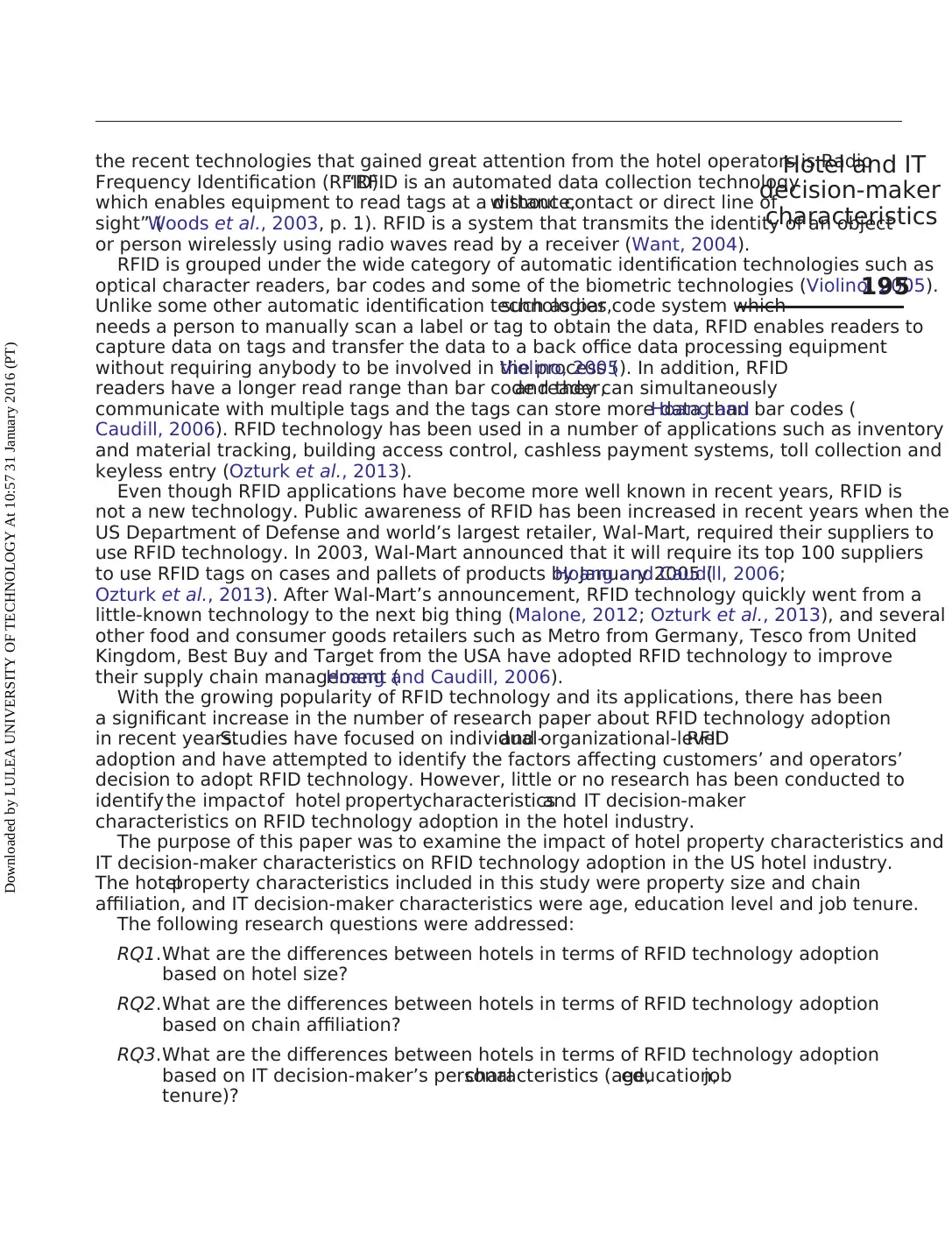
the recent technologies that gained great attention from the hotel operators is Radio
Frequency Identification (RFID).“RFID is an automated data collection technology
which enables equipment to read tags at a distance,without contact or direct line of
sight” (Woods et al., 2003, p. 1). RFID is a system that transmits the identity of an object
or person wirelessly using radio waves read by a receiver (Want, 2004).
RFID is grouped under the wide category of automatic identification technologies such as
optical character readers, bar codes and some of the biometric technologies (Violino, 2005).
Unlike some other automatic identification technologies,such as bar code system which
needs a person to manually scan a label or tag to obtain the data, RFID enables readers to
capture data on tags and transfer the data to a back office data processing equipment
without requiring anybody to be involved in the process (Violino, 2005). In addition, RFID
readers have a longer read range than bar code reader,and they can simultaneously
communicate with multiple tags and the tags can store more data than bar codes (Hoang and
Caudill, 2006). RFID technology has been used in a number of applications such as inventory
and material tracking, building access control, cashless payment systems, toll collection and
keyless entry (Ozturk et al., 2013).
Even though RFID applications have become more well known in recent years, RFID is
not a new technology. Public awareness of RFID has been increased in recent years when the
US Department of Defense and world’s largest retailer, Wal-Mart, required their suppliers to
use RFID technology. In 2003, Wal-Mart announced that it will require its top 100 suppliers
to use RFID tags on cases and pallets of products by January 2005 (Hoang and Caudill, 2006;
Ozturk et al., 2013). After Wal-Mart’s announcement, RFID technology quickly went from a
little-known technology to the next big thing (Malone, 2012; Ozturk et al., 2013), and several
other food and consumer goods retailers such as Metro from Germany, Tesco from United
Kingdom, Best Buy and Target from the USA have adopted RFID technology to improve
their supply chain management (Hoang and Caudill, 2006).
With the growing popularity of RFID technology and its applications, there has been
a significant increase in the number of research paper about RFID technology adoption
in recent years.Studies have focused on individual-and organizational-levelRFID
adoption and have attempted to identify the factors affecting customers’ and operators’
decision to adopt RFID technology. However, little or no research has been conducted to
identify the impactof hotel propertycharacteristicsand IT decision-maker
characteristics on RFID technology adoption in the hotel industry.
The purpose of this paper was to examine the impact of hotel property characteristics and
IT decision-maker characteristics on RFID technology adoption in the US hotel industry.
The hotelproperty characteristics included in this study were property size and chain
affiliation, and IT decision-maker characteristics were age, education level and job tenure.
The following research questions were addressed:
RQ1.What are the differences between hotels in terms of RFID technology adoption
based on hotel size?
RQ2.What are the differences between hotels in terms of RFID technology adoption
based on chain affiliation?
RQ3.What are the differences between hotels in terms of RFID technology adoption
based on IT decision-maker’s personalcharacteristics (age,education,job
tenure)?
195
Hotel and IT
decision-maker
characteristics
Downloaded by LULEA UNIVERSITY OF TECHNOLOGY At 10:57 31 January 2016 (PT)
Frequency Identification (RFID).“RFID is an automated data collection technology
which enables equipment to read tags at a distance,without contact or direct line of
sight” (Woods et al., 2003, p. 1). RFID is a system that transmits the identity of an object
or person wirelessly using radio waves read by a receiver (Want, 2004).
RFID is grouped under the wide category of automatic identification technologies such as
optical character readers, bar codes and some of the biometric technologies (Violino, 2005).
Unlike some other automatic identification technologies,such as bar code system which
needs a person to manually scan a label or tag to obtain the data, RFID enables readers to
capture data on tags and transfer the data to a back office data processing equipment
without requiring anybody to be involved in the process (Violino, 2005). In addition, RFID
readers have a longer read range than bar code reader,and they can simultaneously
communicate with multiple tags and the tags can store more data than bar codes (Hoang and
Caudill, 2006). RFID technology has been used in a number of applications such as inventory
and material tracking, building access control, cashless payment systems, toll collection and
keyless entry (Ozturk et al., 2013).
Even though RFID applications have become more well known in recent years, RFID is
not a new technology. Public awareness of RFID has been increased in recent years when the
US Department of Defense and world’s largest retailer, Wal-Mart, required their suppliers to
use RFID technology. In 2003, Wal-Mart announced that it will require its top 100 suppliers
to use RFID tags on cases and pallets of products by January 2005 (Hoang and Caudill, 2006;
Ozturk et al., 2013). After Wal-Mart’s announcement, RFID technology quickly went from a
little-known technology to the next big thing (Malone, 2012; Ozturk et al., 2013), and several
other food and consumer goods retailers such as Metro from Germany, Tesco from United
Kingdom, Best Buy and Target from the USA have adopted RFID technology to improve
their supply chain management (Hoang and Caudill, 2006).
With the growing popularity of RFID technology and its applications, there has been
a significant increase in the number of research paper about RFID technology adoption
in recent years.Studies have focused on individual-and organizational-levelRFID
adoption and have attempted to identify the factors affecting customers’ and operators’
decision to adopt RFID technology. However, little or no research has been conducted to
identify the impactof hotel propertycharacteristicsand IT decision-maker
characteristics on RFID technology adoption in the hotel industry.
The purpose of this paper was to examine the impact of hotel property characteristics and
IT decision-maker characteristics on RFID technology adoption in the US hotel industry.
The hotelproperty characteristics included in this study were property size and chain
affiliation, and IT decision-maker characteristics were age, education level and job tenure.
The following research questions were addressed:
RQ1.What are the differences between hotels in terms of RFID technology adoption
based on hotel size?
RQ2.What are the differences between hotels in terms of RFID technology adoption
based on chain affiliation?
RQ3.What are the differences between hotels in terms of RFID technology adoption
based on IT decision-maker’s personalcharacteristics (age,education,job
tenure)?
195
Hotel and IT
decision-maker
characteristics
Downloaded by LULEA UNIVERSITY OF TECHNOLOGY At 10:57 31 January 2016 (PT)
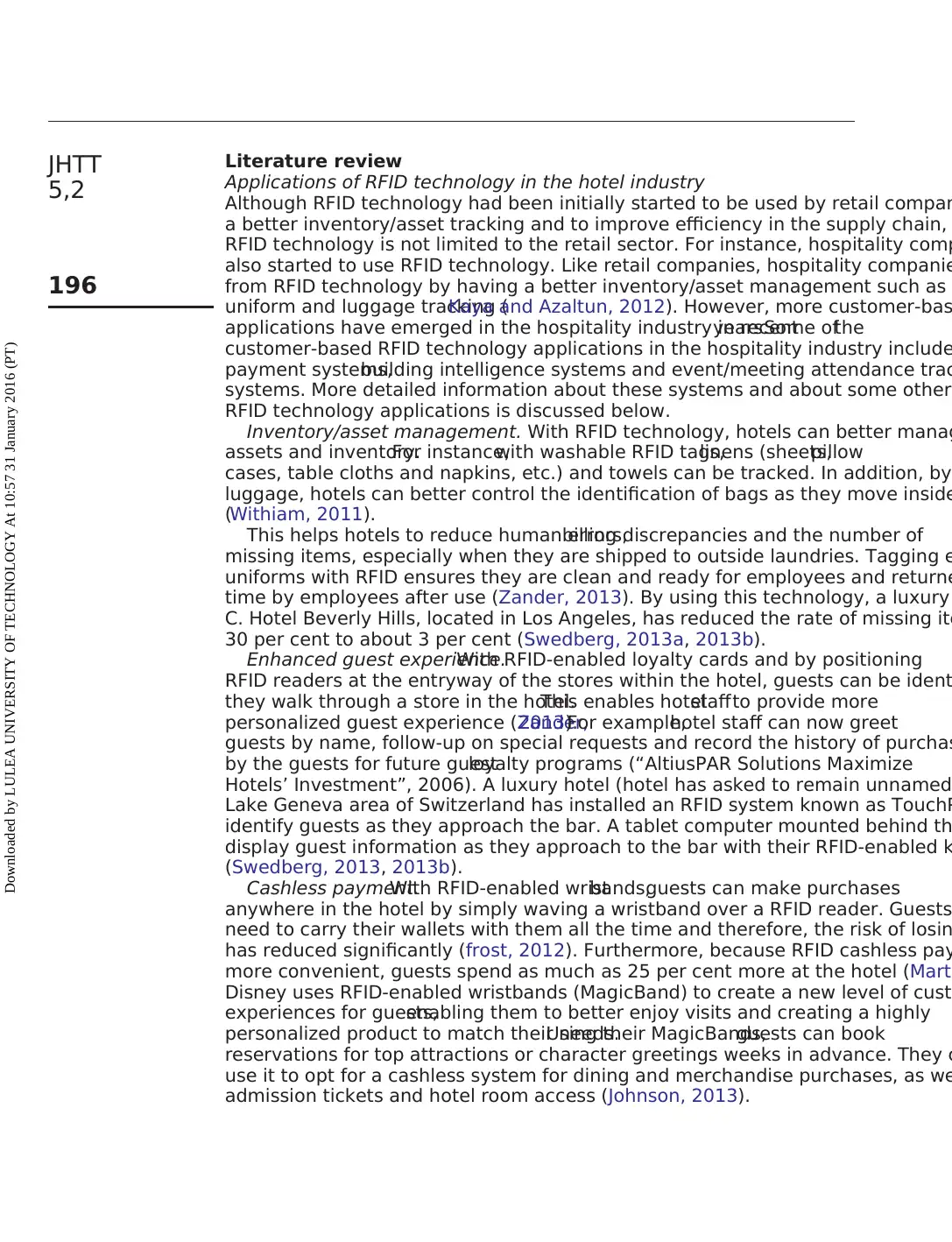
Literature review
Applications of RFID technology in the hotel industry
Although RFID technology had been initially started to be used by retail compan
a better inventory/asset tracking and to improve efficiency in the supply chain,
RFID technology is not limited to the retail sector. For instance, hospitality comp
also started to use RFID technology. Like retail companies, hospitality companie
from RFID technology by having a better inventory/asset management such as
uniform and luggage tracking (Kaya and Azaltun, 2012). However, more customer-bas
applications have emerged in the hospitality industry in recentyears.Some ofthe
customer-based RFID technology applications in the hospitality industry include
payment systems,building intelligence systems and event/meeting attendance trac
systems. More detailed information about these systems and about some other
RFID technology applications is discussed below.
Inventory/asset management. With RFID technology, hotels can better manag
assets and inventory.For instance,with washable RFID tags,linens (sheets,pillow
cases, table cloths and napkins, etc.) and towels can be tracked. In addition, by
luggage, hotels can better control the identification of bags as they move inside
(Withiam, 2011).
This helps hotels to reduce human errors,billing discrepancies and the number of
missing items, especially when they are shipped to outside laundries. Tagging e
uniforms with RFID ensures they are clean and ready for employees and returne
time by employees after use (Zander, 2013). By using this technology, a luxury
C. Hotel Beverly Hills, located in Los Angeles, has reduced the rate of missing ite
30 per cent to about 3 per cent (Swedberg, 2013a, 2013b).
Enhanced guest experience.With RFID-enabled loyalty cards and by positioning
RFID readers at the entryway of the stores within the hotel, guests can be ident
they walk through a store in the hotel.This enables hotelstaffto provide more
personalized guest experience (Zander,2013).For example,hotel staff can now greet
guests by name, follow-up on special requests and record the history of purchas
by the guests for future guestloyalty programs (“AltiusPAR Solutions Maximize
Hotels’ Investment”, 2006). A luxury hotel (hotel has asked to remain unnamed
Lake Geneva area of Switzerland has installed an RFID system known as TouchP
identify guests as they approach the bar. A tablet computer mounted behind th
display guest information as they approach to the bar with their RFID-enabled k
(Swedberg, 2013, 2013b).
Cashless payment.With RFID-enabled wristbands,guests can make purchases
anywhere in the hotel by simply waving a wristband over a RFID reader. Guests
need to carry their wallets with them all the time and therefore, the risk of losin
has reduced significantly (frost, 2012). Furthermore, because RFID cashless pay
more convenient, guests spend as much as 25 per cent more at the hotel (Marti
Disney uses RFID-enabled wristbands (MagicBand) to create a new level of cust
experiences for guests,enabling them to better enjoy visits and creating a highly
personalized product to match their needs.Using their MagicBands,guests can book
reservations for top attractions or character greetings weeks in advance. They c
use it to opt for a cashless system for dining and merchandise purchases, as we
admission tickets and hotel room access (Johnson, 2013).
JHTT
5,2
196
Downloaded by LULEA UNIVERSITY OF TECHNOLOGY At 10:57 31 January 2016 (PT)
Applications of RFID technology in the hotel industry
Although RFID technology had been initially started to be used by retail compan
a better inventory/asset tracking and to improve efficiency in the supply chain,
RFID technology is not limited to the retail sector. For instance, hospitality comp
also started to use RFID technology. Like retail companies, hospitality companie
from RFID technology by having a better inventory/asset management such as
uniform and luggage tracking (Kaya and Azaltun, 2012). However, more customer-bas
applications have emerged in the hospitality industry in recentyears.Some ofthe
customer-based RFID technology applications in the hospitality industry include
payment systems,building intelligence systems and event/meeting attendance trac
systems. More detailed information about these systems and about some other
RFID technology applications is discussed below.
Inventory/asset management. With RFID technology, hotels can better manag
assets and inventory.For instance,with washable RFID tags,linens (sheets,pillow
cases, table cloths and napkins, etc.) and towels can be tracked. In addition, by
luggage, hotels can better control the identification of bags as they move inside
(Withiam, 2011).
This helps hotels to reduce human errors,billing discrepancies and the number of
missing items, especially when they are shipped to outside laundries. Tagging e
uniforms with RFID ensures they are clean and ready for employees and returne
time by employees after use (Zander, 2013). By using this technology, a luxury
C. Hotel Beverly Hills, located in Los Angeles, has reduced the rate of missing ite
30 per cent to about 3 per cent (Swedberg, 2013a, 2013b).
Enhanced guest experience.With RFID-enabled loyalty cards and by positioning
RFID readers at the entryway of the stores within the hotel, guests can be ident
they walk through a store in the hotel.This enables hotelstaffto provide more
personalized guest experience (Zander,2013).For example,hotel staff can now greet
guests by name, follow-up on special requests and record the history of purchas
by the guests for future guestloyalty programs (“AltiusPAR Solutions Maximize
Hotels’ Investment”, 2006). A luxury hotel (hotel has asked to remain unnamed
Lake Geneva area of Switzerland has installed an RFID system known as TouchP
identify guests as they approach the bar. A tablet computer mounted behind th
display guest information as they approach to the bar with their RFID-enabled k
(Swedberg, 2013, 2013b).
Cashless payment.With RFID-enabled wristbands,guests can make purchases
anywhere in the hotel by simply waving a wristband over a RFID reader. Guests
need to carry their wallets with them all the time and therefore, the risk of losin
has reduced significantly (frost, 2012). Furthermore, because RFID cashless pay
more convenient, guests spend as much as 25 per cent more at the hotel (Marti
Disney uses RFID-enabled wristbands (MagicBand) to create a new level of cust
experiences for guests,enabling them to better enjoy visits and creating a highly
personalized product to match their needs.Using their MagicBands,guests can book
reservations for top attractions or character greetings weeks in advance. They c
use it to opt for a cashless system for dining and merchandise purchases, as we
admission tickets and hotel room access (Johnson, 2013).
JHTT
5,2
196
Downloaded by LULEA UNIVERSITY OF TECHNOLOGY At 10:57 31 January 2016 (PT)
Secure Best Marks with AI Grader
Need help grading? Try our AI Grader for instant feedback on your assignments.
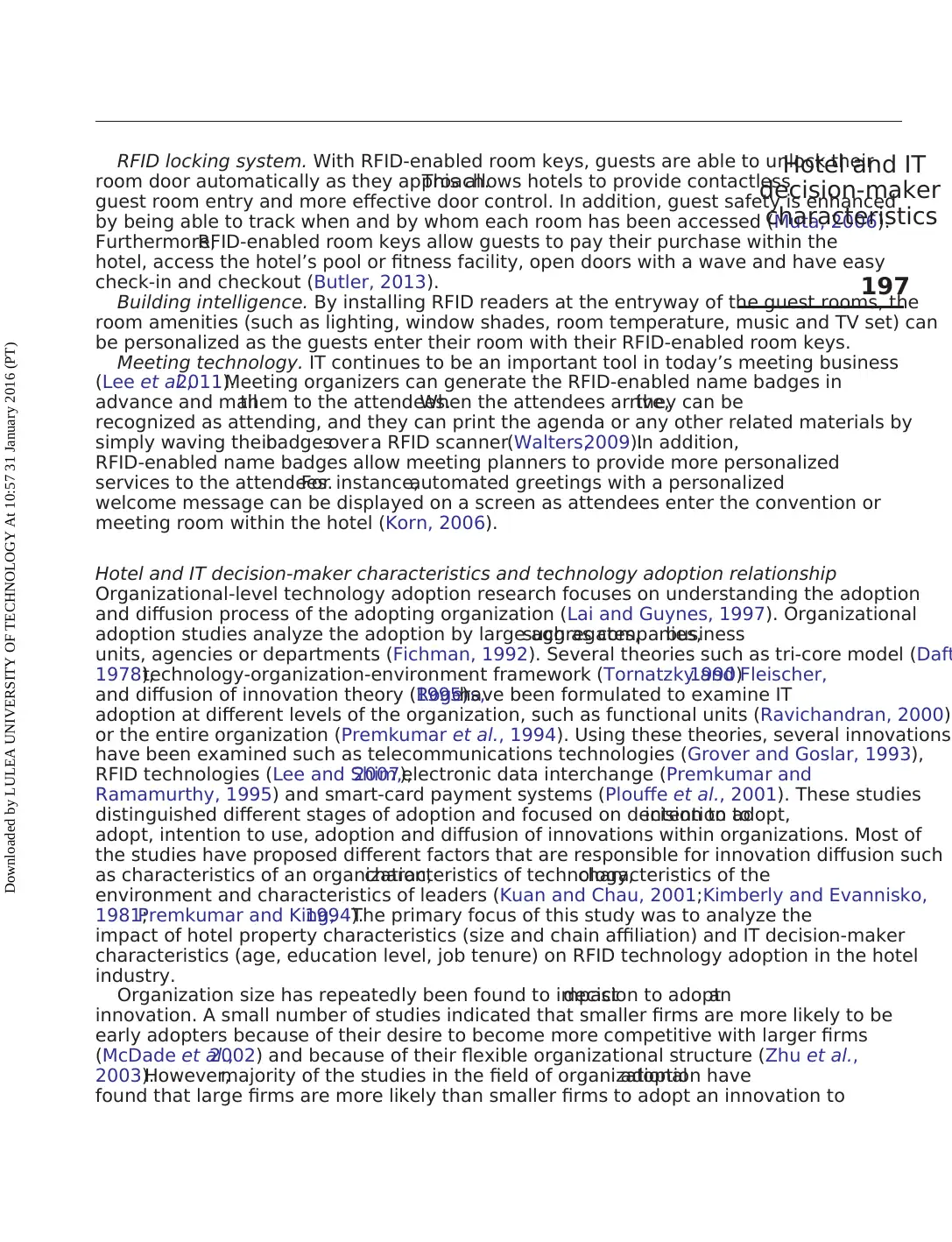
RFID locking system. With RFID-enabled room keys, guests are able to unlock their
room door automatically as they approach.This allows hotels to provide contactless
guest room entry and more effective door control. In addition, guest safety is enhanced
by being able to track when and by whom each room has been accessed (Muta, 2006).
Furthermore,RFID-enabled room keys allow guests to pay their purchase within the
hotel, access the hotel’s pool or fitness facility, open doors with a wave and have easy
check-in and checkout (Butler, 2013).
Building intelligence. By installing RFID readers at the entryway of the guest rooms, the
room amenities (such as lighting, window shades, room temperature, music and TV set) can
be personalized as the guests enter their room with their RFID-enabled room keys.
Meeting technology. IT continues to be an important tool in today’s meeting business
(Lee et al.,2011).Meeting organizers can generate the RFID-enabled name badges in
advance and mailthem to the attendees.When the attendees arrive,they can be
recognized as attending, and they can print the agenda or any other related materials by
simply waving theirbadgesover a RFID scanner(Walters,2009).In addition,
RFID-enabled name badges allow meeting planners to provide more personalized
services to the attendees.For instance,automated greetings with a personalized
welcome message can be displayed on a screen as attendees enter the convention or
meeting room within the hotel (Korn, 2006).
Hotel and IT decision-maker characteristics and technology adoption relationship
Organizational-level technology adoption research focuses on understanding the adoption
and diffusion process of the adopting organization (Lai and Guynes, 1997). Organizational
adoption studies analyze the adoption by large aggregates,such as companies,business
units, agencies or departments (Fichman, 1992). Several theories such as tri-core model (Daft
1978),technology-organization-environment framework (Tornatzky and Fleischer,1990)
and diffusion of innovation theory (Rogers,1995)have been formulated to examine IT
adoption at different levels of the organization, such as functional units (Ravichandran, 2000)
or the entire organization (Premkumar et al., 1994). Using these theories, several innovations
have been examined such as telecommunications technologies (Grover and Goslar, 1993),
RFID technologies (Lee and Shim,2007),electronic data interchange (Premkumar and
Ramamurthy, 1995) and smart-card payment systems (Plouffe et al., 2001). These studies
distinguished different stages of adoption and focused on decision to adopt,intention to
adopt, intention to use, adoption and diffusion of innovations within organizations. Most of
the studies have proposed different factors that are responsible for innovation diffusion such
as characteristics of an organization,characteristics of technology,characteristics of the
environment and characteristics of leaders (Kuan and Chau, 2001;Kimberly and Evannisko,
1981;Premkumar and King,1994).The primary focus of this study was to analyze the
impact of hotel property characteristics (size and chain affiliation) and IT decision-maker
characteristics (age, education level, job tenure) on RFID technology adoption in the hotel
industry.
Organization size has repeatedly been found to impactdecision to adoptan
innovation. A small number of studies indicated that smaller firms are more likely to be
early adopters because of their desire to become more competitive with larger firms
(McDade et al.,2002) and because of their flexible organizational structure (Zhu et al.,
2003).However,majority of the studies in the field of organizationaladoption have
found that large firms are more likely than smaller firms to adopt an innovation to
197
Hotel and IT
decision-maker
characteristics
Downloaded by LULEA UNIVERSITY OF TECHNOLOGY At 10:57 31 January 2016 (PT)
room door automatically as they approach.This allows hotels to provide contactless
guest room entry and more effective door control. In addition, guest safety is enhanced
by being able to track when and by whom each room has been accessed (Muta, 2006).
Furthermore,RFID-enabled room keys allow guests to pay their purchase within the
hotel, access the hotel’s pool or fitness facility, open doors with a wave and have easy
check-in and checkout (Butler, 2013).
Building intelligence. By installing RFID readers at the entryway of the guest rooms, the
room amenities (such as lighting, window shades, room temperature, music and TV set) can
be personalized as the guests enter their room with their RFID-enabled room keys.
Meeting technology. IT continues to be an important tool in today’s meeting business
(Lee et al.,2011).Meeting organizers can generate the RFID-enabled name badges in
advance and mailthem to the attendees.When the attendees arrive,they can be
recognized as attending, and they can print the agenda or any other related materials by
simply waving theirbadgesover a RFID scanner(Walters,2009).In addition,
RFID-enabled name badges allow meeting planners to provide more personalized
services to the attendees.For instance,automated greetings with a personalized
welcome message can be displayed on a screen as attendees enter the convention or
meeting room within the hotel (Korn, 2006).
Hotel and IT decision-maker characteristics and technology adoption relationship
Organizational-level technology adoption research focuses on understanding the adoption
and diffusion process of the adopting organization (Lai and Guynes, 1997). Organizational
adoption studies analyze the adoption by large aggregates,such as companies,business
units, agencies or departments (Fichman, 1992). Several theories such as tri-core model (Daft
1978),technology-organization-environment framework (Tornatzky and Fleischer,1990)
and diffusion of innovation theory (Rogers,1995)have been formulated to examine IT
adoption at different levels of the organization, such as functional units (Ravichandran, 2000)
or the entire organization (Premkumar et al., 1994). Using these theories, several innovations
have been examined such as telecommunications technologies (Grover and Goslar, 1993),
RFID technologies (Lee and Shim,2007),electronic data interchange (Premkumar and
Ramamurthy, 1995) and smart-card payment systems (Plouffe et al., 2001). These studies
distinguished different stages of adoption and focused on decision to adopt,intention to
adopt, intention to use, adoption and diffusion of innovations within organizations. Most of
the studies have proposed different factors that are responsible for innovation diffusion such
as characteristics of an organization,characteristics of technology,characteristics of the
environment and characteristics of leaders (Kuan and Chau, 2001;Kimberly and Evannisko,
1981;Premkumar and King,1994).The primary focus of this study was to analyze the
impact of hotel property characteristics (size and chain affiliation) and IT decision-maker
characteristics (age, education level, job tenure) on RFID technology adoption in the hotel
industry.
Organization size has repeatedly been found to impactdecision to adoptan
innovation. A small number of studies indicated that smaller firms are more likely to be
early adopters because of their desire to become more competitive with larger firms
(McDade et al.,2002) and because of their flexible organizational structure (Zhu et al.,
2003).However,majority of the studies in the field of organizationaladoption have
found that large firms are more likely than smaller firms to adopt an innovation to
197
Hotel and IT
decision-maker
characteristics
Downloaded by LULEA UNIVERSITY OF TECHNOLOGY At 10:57 31 January 2016 (PT)
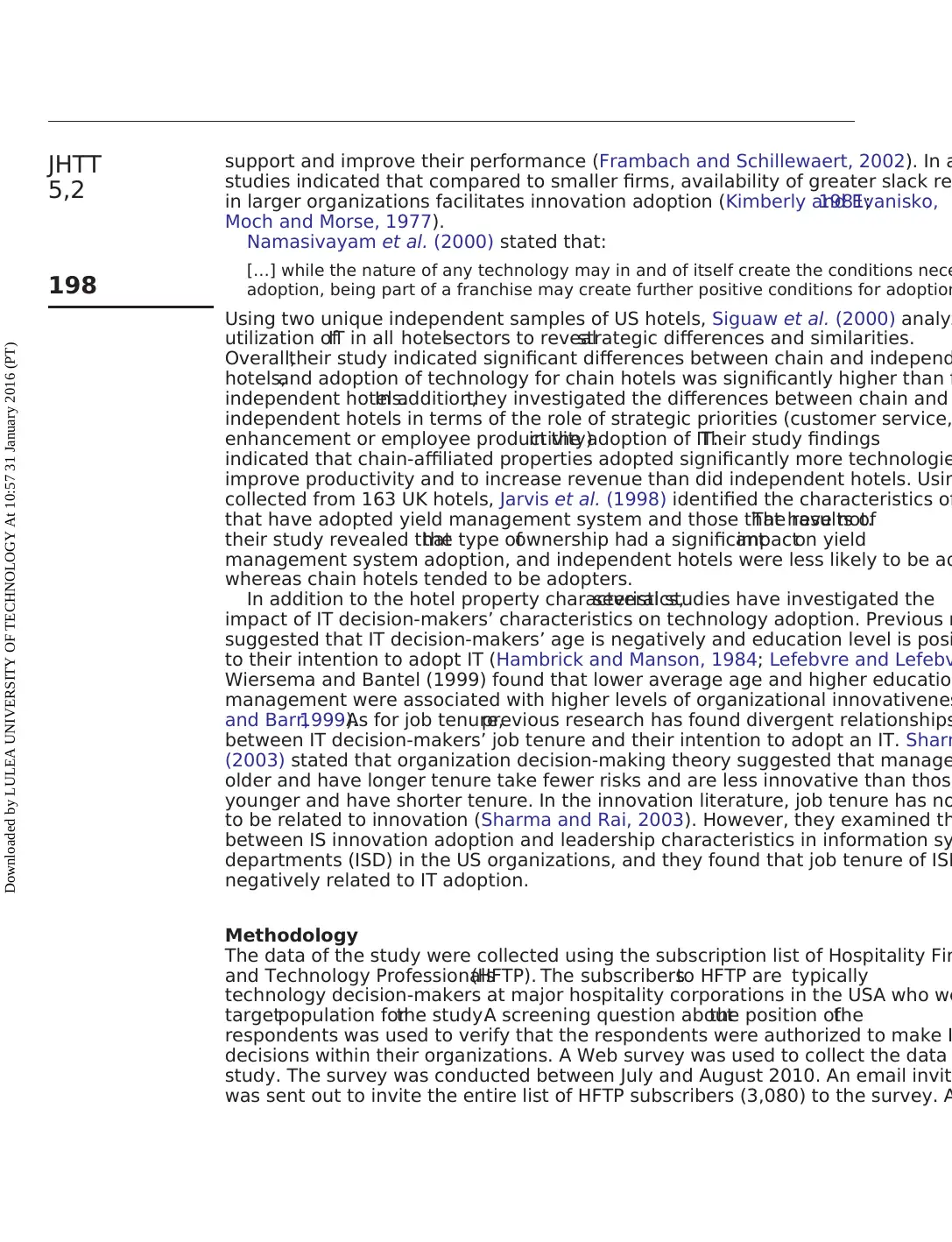
support and improve their performance (Frambach and Schillewaert, 2002). In a
studies indicated that compared to smaller firms, availability of greater slack re
in larger organizations facilitates innovation adoption (Kimberly and Evanisko,1981;
Moch and Morse, 1977).
Namasivayam et al. (2000) stated that:
[…] while the nature of any technology may in and of itself create the conditions nece
adoption, being part of a franchise may create further positive conditions for adoption
Using two unique independent samples of US hotels, Siguaw et al. (2000) analyz
utilization ofIT in all hotelsectors to revealstrategic differences and similarities.
Overall,their study indicated significant differences between chain and independ
hotels,and adoption of technology for chain hotels was significantly higher than f
independent hotels.In addition,they investigated the differences between chain and
independent hotels in terms of the role of strategic priorities (customer service,
enhancement or employee productivity)in the adoption of IT.Their study findings
indicated that chain-affiliated properties adopted significantly more technologie
improve productivity and to increase revenue than did independent hotels. Usin
collected from 163 UK hotels, Jarvis et al. (1998) identified the characteristics of
that have adopted yield management system and those that have not.The results of
their study revealed thatthe type ofownership had a significantimpacton yield
management system adoption, and independent hotels were less likely to be ad
whereas chain hotels tended to be adopters.
In addition to the hotel property characteristics,several studies have investigated the
impact of IT decision-makers’ characteristics on technology adoption. Previous r
suggested that IT decision-makers’ age is negatively and education level is posi
to their intention to adopt IT (Hambrick and Manson, 1984; Lefebvre and Lefebv
Wiersema and Bantel (1999) found that lower average age and higher education
management were associated with higher levels of organizational innovativenes
and Barr,1999).As for job tenure,previous research has found divergent relationships
between IT decision-makers’ job tenure and their intention to adopt an IT. Sharm
(2003) stated that organization decision-making theory suggested that manage
older and have longer tenure take fewer risks and are less innovative than those
younger and have shorter tenure. In the innovation literature, job tenure has no
to be related to innovation (Sharma and Rai, 2003). However, they examined th
between IS innovation adoption and leadership characteristics in information sy
departments (ISD) in the US organizations, and they found that job tenure of ISD
negatively related to IT adoption.
Methodology
The data of the study were collected using the subscription list of Hospitality Fin
and Technology Professionals(HFTP). The subscribersto HFTP are typically
technology decision-makers at major hospitality corporations in the USA who we
targetpopulation forthe study.A screening question aboutthe position ofthe
respondents was used to verify that the respondents were authorized to make I
decisions within their organizations. A Web survey was used to collect the data
study. The survey was conducted between July and August 2010. An email invit
was sent out to invite the entire list of HFTP subscribers (3,080) to the survey. A
JHTT
5,2
198
Downloaded by LULEA UNIVERSITY OF TECHNOLOGY At 10:57 31 January 2016 (PT)
studies indicated that compared to smaller firms, availability of greater slack re
in larger organizations facilitates innovation adoption (Kimberly and Evanisko,1981;
Moch and Morse, 1977).
Namasivayam et al. (2000) stated that:
[…] while the nature of any technology may in and of itself create the conditions nece
adoption, being part of a franchise may create further positive conditions for adoption
Using two unique independent samples of US hotels, Siguaw et al. (2000) analyz
utilization ofIT in all hotelsectors to revealstrategic differences and similarities.
Overall,their study indicated significant differences between chain and independ
hotels,and adoption of technology for chain hotels was significantly higher than f
independent hotels.In addition,they investigated the differences between chain and
independent hotels in terms of the role of strategic priorities (customer service,
enhancement or employee productivity)in the adoption of IT.Their study findings
indicated that chain-affiliated properties adopted significantly more technologie
improve productivity and to increase revenue than did independent hotels. Usin
collected from 163 UK hotels, Jarvis et al. (1998) identified the characteristics of
that have adopted yield management system and those that have not.The results of
their study revealed thatthe type ofownership had a significantimpacton yield
management system adoption, and independent hotels were less likely to be ad
whereas chain hotels tended to be adopters.
In addition to the hotel property characteristics,several studies have investigated the
impact of IT decision-makers’ characteristics on technology adoption. Previous r
suggested that IT decision-makers’ age is negatively and education level is posi
to their intention to adopt IT (Hambrick and Manson, 1984; Lefebvre and Lefebv
Wiersema and Bantel (1999) found that lower average age and higher education
management were associated with higher levels of organizational innovativenes
and Barr,1999).As for job tenure,previous research has found divergent relationships
between IT decision-makers’ job tenure and their intention to adopt an IT. Sharm
(2003) stated that organization decision-making theory suggested that manage
older and have longer tenure take fewer risks and are less innovative than those
younger and have shorter tenure. In the innovation literature, job tenure has no
to be related to innovation (Sharma and Rai, 2003). However, they examined th
between IS innovation adoption and leadership characteristics in information sy
departments (ISD) in the US organizations, and they found that job tenure of ISD
negatively related to IT adoption.
Methodology
The data of the study were collected using the subscription list of Hospitality Fin
and Technology Professionals(HFTP). The subscribersto HFTP are typically
technology decision-makers at major hospitality corporations in the USA who we
targetpopulation forthe study.A screening question aboutthe position ofthe
respondents was used to verify that the respondents were authorized to make I
decisions within their organizations. A Web survey was used to collect the data
study. The survey was conducted between July and August 2010. An email invit
was sent out to invite the entire list of HFTP subscribers (3,080) to the survey. A
JHTT
5,2
198
Downloaded by LULEA UNIVERSITY OF TECHNOLOGY At 10:57 31 January 2016 (PT)
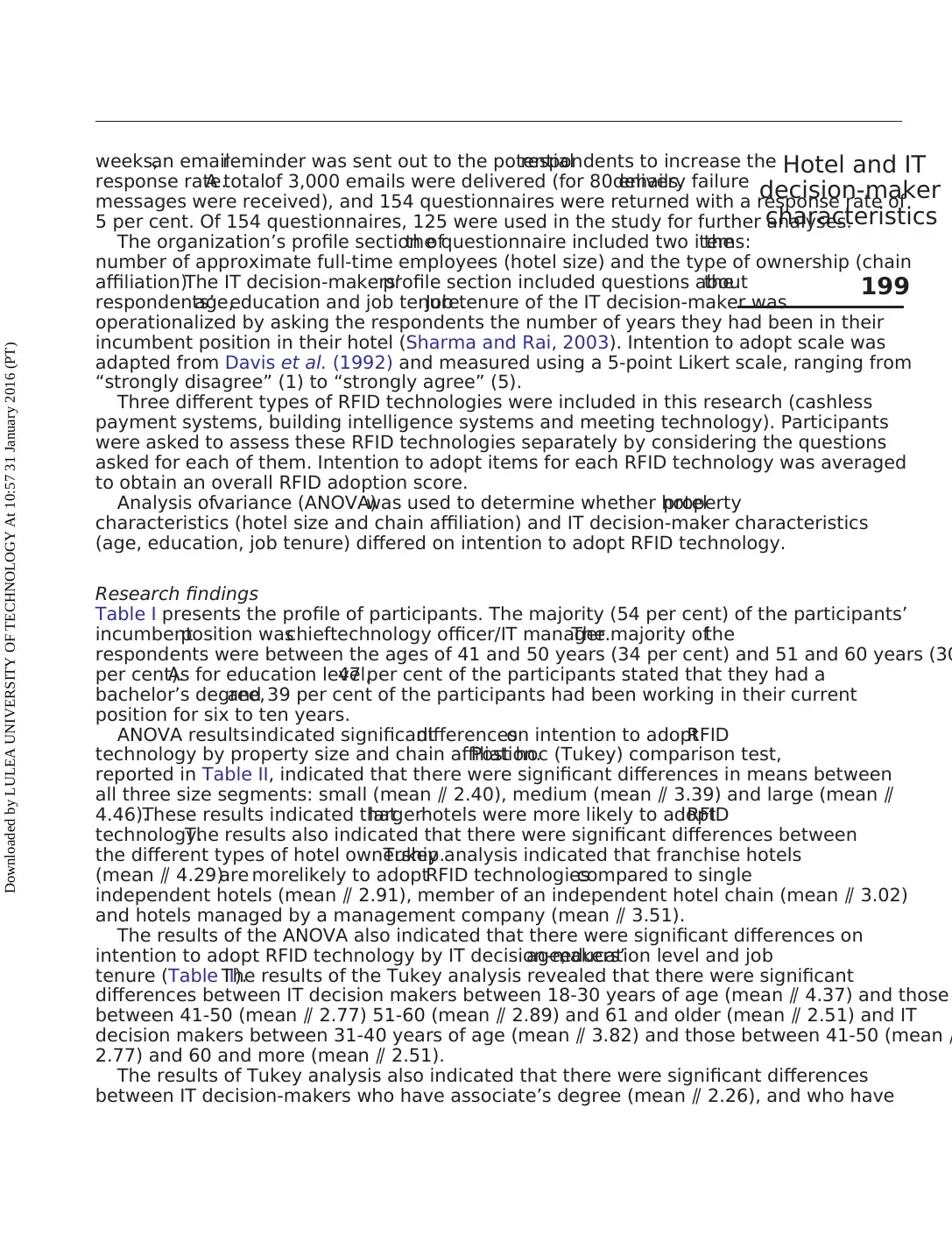
weeks,an emailreminder was sent out to the potentialrespondents to increase the
response rate.A totalof 3,000 emails were delivered (for 80 emails,delivery failure
messages were received), and 154 questionnaires were returned with a response rate of
5 per cent. Of 154 questionnaires, 125 were used in the study for further analyses.
The organization’s profile section ofthe questionnaire included two items:the
number of approximate full-time employees (hotel size) and the type of ownership (chain
affiliation).The IT decision-makers’profile section included questions aboutthe
respondents’age,education and job tenure.Job tenure of the IT decision-maker was
operationalized by asking the respondents the number of years they had been in their
incumbent position in their hotel (Sharma and Rai, 2003). Intention to adopt scale was
adapted from Davis et al. (1992) and measured using a 5-point Likert scale, ranging from
“strongly disagree” (1) to “strongly agree” (5).
Three different types of RFID technologies were included in this research (cashless
payment systems, building intelligence systems and meeting technology). Participants
were asked to assess these RFID technologies separately by considering the questions
asked for each of them. Intention to adopt items for each RFID technology was averaged
to obtain an overall RFID adoption score.
Analysis ofvariance (ANOVA)was used to determine whether hotelproperty
characteristics (hotel size and chain affiliation) and IT decision-maker characteristics
(age, education, job tenure) differed on intention to adopt RFID technology.
Research findings
Table I presents the profile of participants. The majority (54 per cent) of the participants’
incumbentposition waschieftechnology officer/IT manager.The majority ofthe
respondents were between the ages of 41 and 50 years (34 per cent) and 51 and 60 years (30
per cent).As for education level,47 per cent of the participants stated that they had a
bachelor’s degree,and 39 per cent of the participants had been working in their current
position for six to ten years.
ANOVA resultsindicated significantdifferenceson intention to adoptRFID
technology by property size and chain affiliation.Post hoc (Tukey) comparison test,
reported in Table II, indicated that there were significant differences in means between
all three size segments: small (mean ⫽ 2.40), medium (mean ⫽ 3.39) and large (mean ⫽
4.46).These results indicated thatlargerhotels were more likely to adoptRFID
technology.The results also indicated that there were significant differences between
the different types of hotel ownership.Tukey analysis indicated that franchise hotels
(mean ⫽ 4.29)are morelikely to adoptRFID technologiescompared to single
independent hotels (mean ⫽ 2.91), member of an independent hotel chain (mean ⫽ 3.02)
and hotels managed by a management company (mean ⫽ 3.51).
The results of the ANOVA also indicated that there were significant differences on
intention to adopt RFID technology by IT decision-makers’age,education level and job
tenure (Table II).The results of the Tukey analysis revealed that there were significant
differences between IT decision makers between 18-30 years of age (mean ⫽ 4.37) and those
between 41-50 (mean ⫽ 2.77) 51-60 (mean ⫽ 2.89) and 61 and older (mean ⫽ 2.51) and IT
decision makers between 31-40 years of age (mean ⫽ 3.82) and those between 41-50 (mean ⫽
2.77) and 60 and more (mean ⫽ 2.51).
The results of Tukey analysis also indicated that there were significant differences
between IT decision-makers who have associate’s degree (mean ⫽ 2.26), and who have
199
Hotel and IT
decision-maker
characteristics
Downloaded by LULEA UNIVERSITY OF TECHNOLOGY At 10:57 31 January 2016 (PT)
response rate.A totalof 3,000 emails were delivered (for 80 emails,delivery failure
messages were received), and 154 questionnaires were returned with a response rate of
5 per cent. Of 154 questionnaires, 125 were used in the study for further analyses.
The organization’s profile section ofthe questionnaire included two items:the
number of approximate full-time employees (hotel size) and the type of ownership (chain
affiliation).The IT decision-makers’profile section included questions aboutthe
respondents’age,education and job tenure.Job tenure of the IT decision-maker was
operationalized by asking the respondents the number of years they had been in their
incumbent position in their hotel (Sharma and Rai, 2003). Intention to adopt scale was
adapted from Davis et al. (1992) and measured using a 5-point Likert scale, ranging from
“strongly disagree” (1) to “strongly agree” (5).
Three different types of RFID technologies were included in this research (cashless
payment systems, building intelligence systems and meeting technology). Participants
were asked to assess these RFID technologies separately by considering the questions
asked for each of them. Intention to adopt items for each RFID technology was averaged
to obtain an overall RFID adoption score.
Analysis ofvariance (ANOVA)was used to determine whether hotelproperty
characteristics (hotel size and chain affiliation) and IT decision-maker characteristics
(age, education, job tenure) differed on intention to adopt RFID technology.
Research findings
Table I presents the profile of participants. The majority (54 per cent) of the participants’
incumbentposition waschieftechnology officer/IT manager.The majority ofthe
respondents were between the ages of 41 and 50 years (34 per cent) and 51 and 60 years (30
per cent).As for education level,47 per cent of the participants stated that they had a
bachelor’s degree,and 39 per cent of the participants had been working in their current
position for six to ten years.
ANOVA resultsindicated significantdifferenceson intention to adoptRFID
technology by property size and chain affiliation.Post hoc (Tukey) comparison test,
reported in Table II, indicated that there were significant differences in means between
all three size segments: small (mean ⫽ 2.40), medium (mean ⫽ 3.39) and large (mean ⫽
4.46).These results indicated thatlargerhotels were more likely to adoptRFID
technology.The results also indicated that there were significant differences between
the different types of hotel ownership.Tukey analysis indicated that franchise hotels
(mean ⫽ 4.29)are morelikely to adoptRFID technologiescompared to single
independent hotels (mean ⫽ 2.91), member of an independent hotel chain (mean ⫽ 3.02)
and hotels managed by a management company (mean ⫽ 3.51).
The results of the ANOVA also indicated that there were significant differences on
intention to adopt RFID technology by IT decision-makers’age,education level and job
tenure (Table II).The results of the Tukey analysis revealed that there were significant
differences between IT decision makers between 18-30 years of age (mean ⫽ 4.37) and those
between 41-50 (mean ⫽ 2.77) 51-60 (mean ⫽ 2.89) and 61 and older (mean ⫽ 2.51) and IT
decision makers between 31-40 years of age (mean ⫽ 3.82) and those between 41-50 (mean ⫽
2.77) and 60 and more (mean ⫽ 2.51).
The results of Tukey analysis also indicated that there were significant differences
between IT decision-makers who have associate’s degree (mean ⫽ 2.26), and who have
199
Hotel and IT
decision-maker
characteristics
Downloaded by LULEA UNIVERSITY OF TECHNOLOGY At 10:57 31 January 2016 (PT)
Paraphrase This Document
Need a fresh take? Get an instant paraphrase of this document with our AI Paraphraser
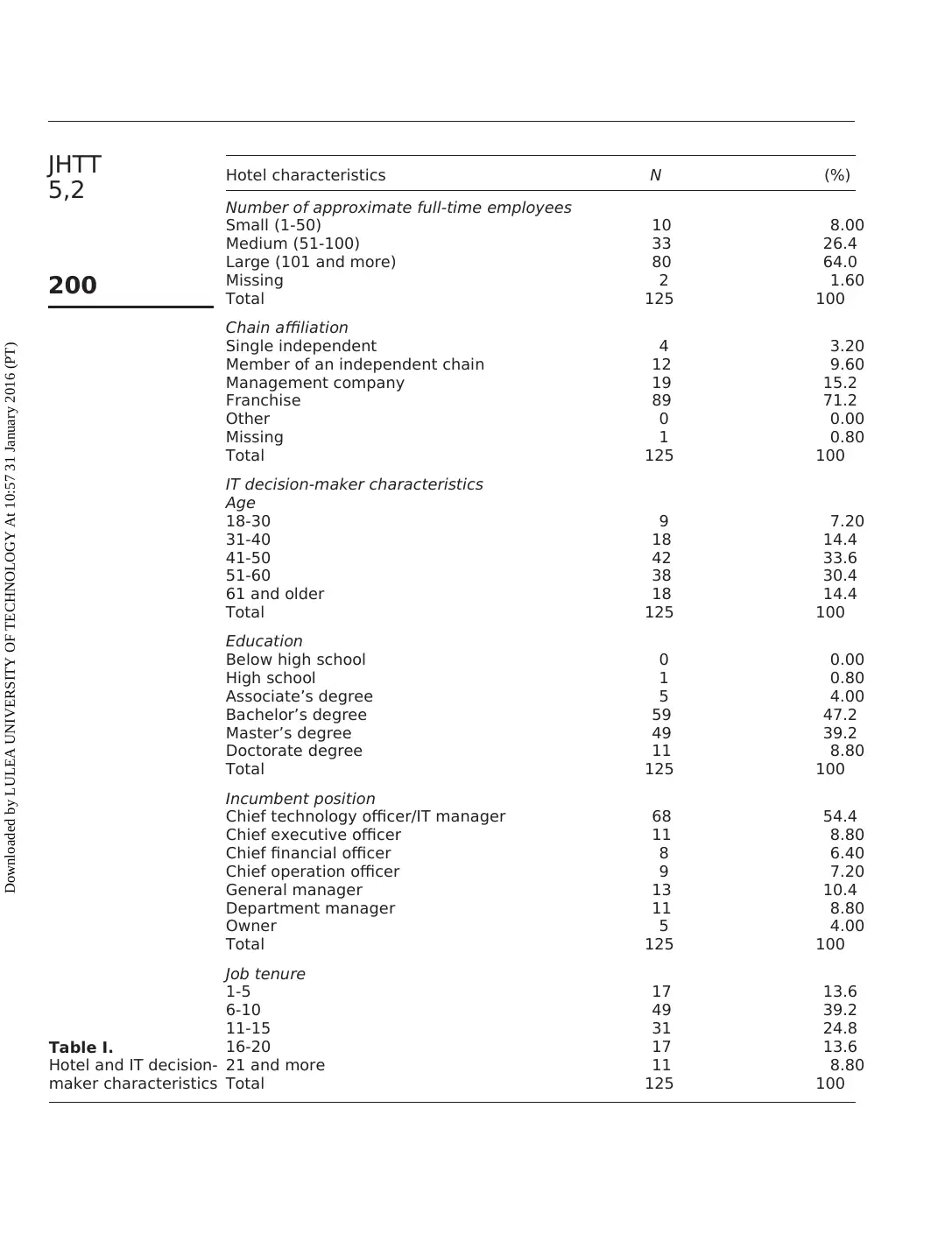
Table I.
Hotel and IT decision-
maker characteristics
Hotel characteristics N (%)
Number of approximate full-time employees
Small (1-50) 10 8.00
Medium (51-100) 33 26.4
Large (101 and more) 80 64.0
Missing 2 1.60
Total 125 100
Chain affiliation
Single independent 4 3.20
Member of an independent chain 12 9.60
Management company 19 15.2
Franchise 89 71.2
Other 0 0.00
Missing 1 0.80
Total 125 100
IT decision-maker characteristics
Age
18-30 9 7.20
31-40 18 14.4
41-50 42 33.6
51-60 38 30.4
61 and older 18 14.4
Total 125 100
Education
Below high school 0 0.00
High school 1 0.80
Associate’s degree 5 4.00
Bachelor’s degree 59 47.2
Master’s degree 49 39.2
Doctorate degree 11 8.80
Total 125 100
Incumbent position
Chief technology officer/IT manager 68 54.4
Chief executive officer 11 8.80
Chief financial officer 8 6.40
Chief operation officer 9 7.20
General manager 13 10.4
Department manager 11 8.80
Owner 5 4.00
Total 125 100
Job tenure
1-5 17 13.6
6-10 49 39.2
11-15 31 24.8
16-20 17 13.6
21 and more 11 8.80
Total 125 100
JHTT
5,2
200
Downloaded by LULEA UNIVERSITY OF TECHNOLOGY At 10:57 31 January 2016 (PT)
Hotel and IT decision-
maker characteristics
Hotel characteristics N (%)
Number of approximate full-time employees
Small (1-50) 10 8.00
Medium (51-100) 33 26.4
Large (101 and more) 80 64.0
Missing 2 1.60
Total 125 100
Chain affiliation
Single independent 4 3.20
Member of an independent chain 12 9.60
Management company 19 15.2
Franchise 89 71.2
Other 0 0.00
Missing 1 0.80
Total 125 100
IT decision-maker characteristics
Age
18-30 9 7.20
31-40 18 14.4
41-50 42 33.6
51-60 38 30.4
61 and older 18 14.4
Total 125 100
Education
Below high school 0 0.00
High school 1 0.80
Associate’s degree 5 4.00
Bachelor’s degree 59 47.2
Master’s degree 49 39.2
Doctorate degree 11 8.80
Total 125 100
Incumbent position
Chief technology officer/IT manager 68 54.4
Chief executive officer 11 8.80
Chief financial officer 8 6.40
Chief operation officer 9 7.20
General manager 13 10.4
Department manager 11 8.80
Owner 5 4.00
Total 125 100
Job tenure
1-5 17 13.6
6-10 49 39.2
11-15 31 24.8
16-20 17 13.6
21 and more 11 8.80
Total 125 100
JHTT
5,2
200
Downloaded by LULEA UNIVERSITY OF TECHNOLOGY At 10:57 31 January 2016 (PT)
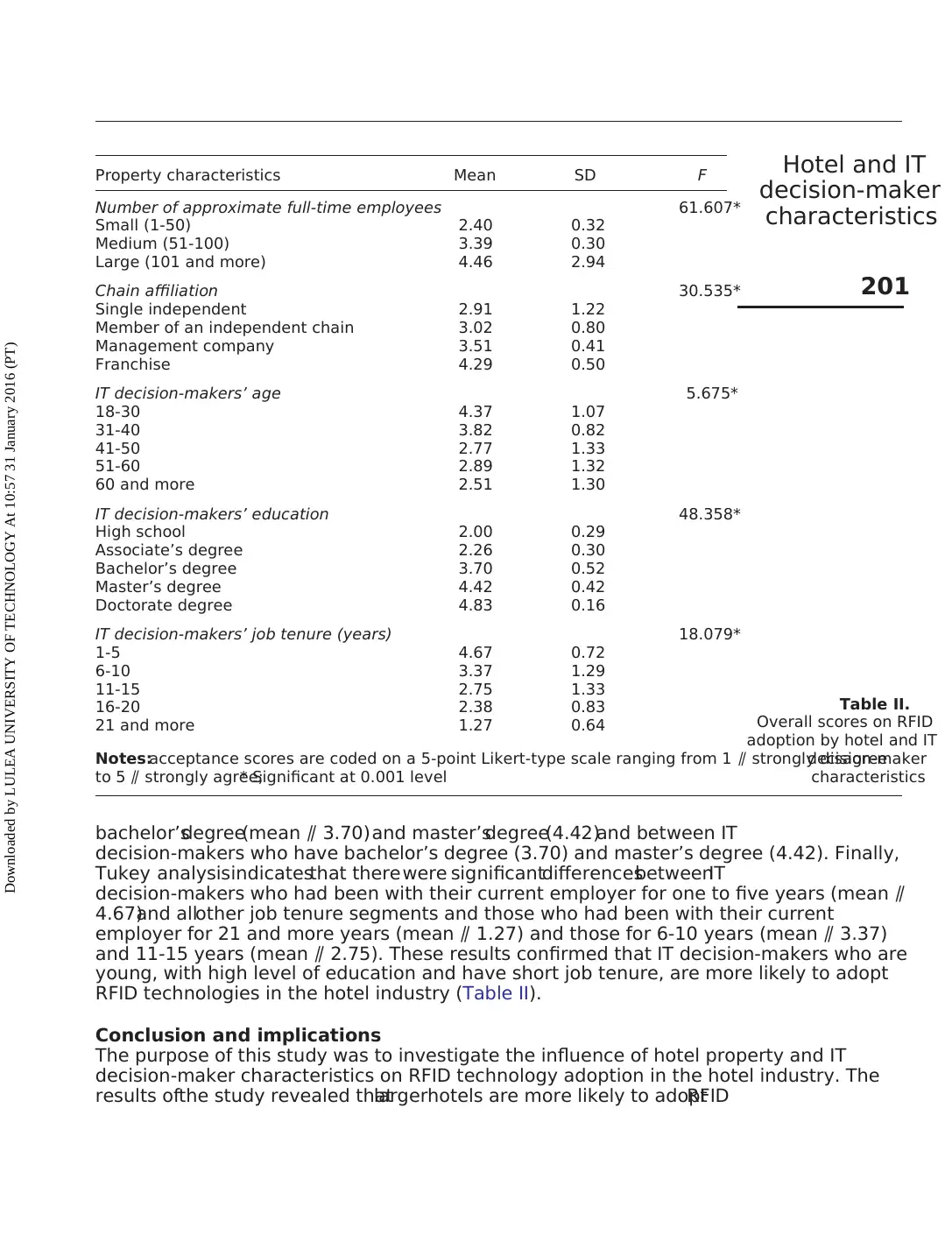
bachelor’sdegree(mean ⫽ 3.70)and master’sdegree(4.42)and between IT
decision-makers who have bachelor’s degree (3.70) and master’s degree (4.42). Finally,
Tukey analysisindicatesthat therewere significantdifferencesbetweenIT
decision-makers who had been with their current employer for one to five years (mean ⫽
4.67)and allother job tenure segments and those who had been with their current
employer for 21 and more years (mean ⫽ 1.27) and those for 6-10 years (mean ⫽ 3.37)
and 11-15 years (mean ⫽ 2.75). These results confirmed that IT decision-makers who are
young, with high level of education and have short job tenure, are more likely to adopt
RFID technologies in the hotel industry (Table II).
Conclusion and implications
The purpose of this study was to investigate the influence of hotel property and IT
decision-maker characteristics on RFID technology adoption in the hotel industry. The
results ofthe study revealed thatlargerhotels are more likely to adoptRFID
Table II.
Overall scores on RFID
adoption by hotel and IT
decision-maker
characteristics
Property characteristics Mean SD F
Number of approximate full-time employees 61.607*
Small (1-50) 2.40 0.32
Medium (51-100) 3.39 0.30
Large (101 and more) 4.46 2.94
Chain affiliation 30.535*
Single independent 2.91 1.22
Member of an independent chain 3.02 0.80
Management company 3.51 0.41
Franchise 4.29 0.50
IT decision-makers’ age 5.675*
18-30 4.37 1.07
31-40 3.82 0.82
41-50 2.77 1.33
51-60 2.89 1.32
60 and more 2.51 1.30
IT decision-makers’ education 48.358*
High school 2.00 0.29
Associate’s degree 2.26 0.30
Bachelor’s degree 3.70 0.52
Master’s degree 4.42 0.42
Doctorate degree 4.83 0.16
IT decision-makers’ job tenure (years) 18.079*
1-5 4.67 0.72
6-10 3.37 1.29
11-15 2.75 1.33
16-20 2.38 0.83
21 and more 1.27 0.64
Notes:acceptance scores are coded on a 5-point Likert-type scale ranging from 1 ⫽ strongly disagree
to 5 ⫽ strongly agree;* Significant at 0.001 level
201
Hotel and IT
decision-maker
characteristics
Downloaded by LULEA UNIVERSITY OF TECHNOLOGY At 10:57 31 January 2016 (PT)
decision-makers who have bachelor’s degree (3.70) and master’s degree (4.42). Finally,
Tukey analysisindicatesthat therewere significantdifferencesbetweenIT
decision-makers who had been with their current employer for one to five years (mean ⫽
4.67)and allother job tenure segments and those who had been with their current
employer for 21 and more years (mean ⫽ 1.27) and those for 6-10 years (mean ⫽ 3.37)
and 11-15 years (mean ⫽ 2.75). These results confirmed that IT decision-makers who are
young, with high level of education and have short job tenure, are more likely to adopt
RFID technologies in the hotel industry (Table II).
Conclusion and implications
The purpose of this study was to investigate the influence of hotel property and IT
decision-maker characteristics on RFID technology adoption in the hotel industry. The
results ofthe study revealed thatlargerhotels are more likely to adoptRFID
Table II.
Overall scores on RFID
adoption by hotel and IT
decision-maker
characteristics
Property characteristics Mean SD F
Number of approximate full-time employees 61.607*
Small (1-50) 2.40 0.32
Medium (51-100) 3.39 0.30
Large (101 and more) 4.46 2.94
Chain affiliation 30.535*
Single independent 2.91 1.22
Member of an independent chain 3.02 0.80
Management company 3.51 0.41
Franchise 4.29 0.50
IT decision-makers’ age 5.675*
18-30 4.37 1.07
31-40 3.82 0.82
41-50 2.77 1.33
51-60 2.89 1.32
60 and more 2.51 1.30
IT decision-makers’ education 48.358*
High school 2.00 0.29
Associate’s degree 2.26 0.30
Bachelor’s degree 3.70 0.52
Master’s degree 4.42 0.42
Doctorate degree 4.83 0.16
IT decision-makers’ job tenure (years) 18.079*
1-5 4.67 0.72
6-10 3.37 1.29
11-15 2.75 1.33
16-20 2.38 0.83
21 and more 1.27 0.64
Notes:acceptance scores are coded on a 5-point Likert-type scale ranging from 1 ⫽ strongly disagree
to 5 ⫽ strongly agree;* Significant at 0.001 level
201
Hotel and IT
decision-maker
characteristics
Downloaded by LULEA UNIVERSITY OF TECHNOLOGY At 10:57 31 January 2016 (PT)
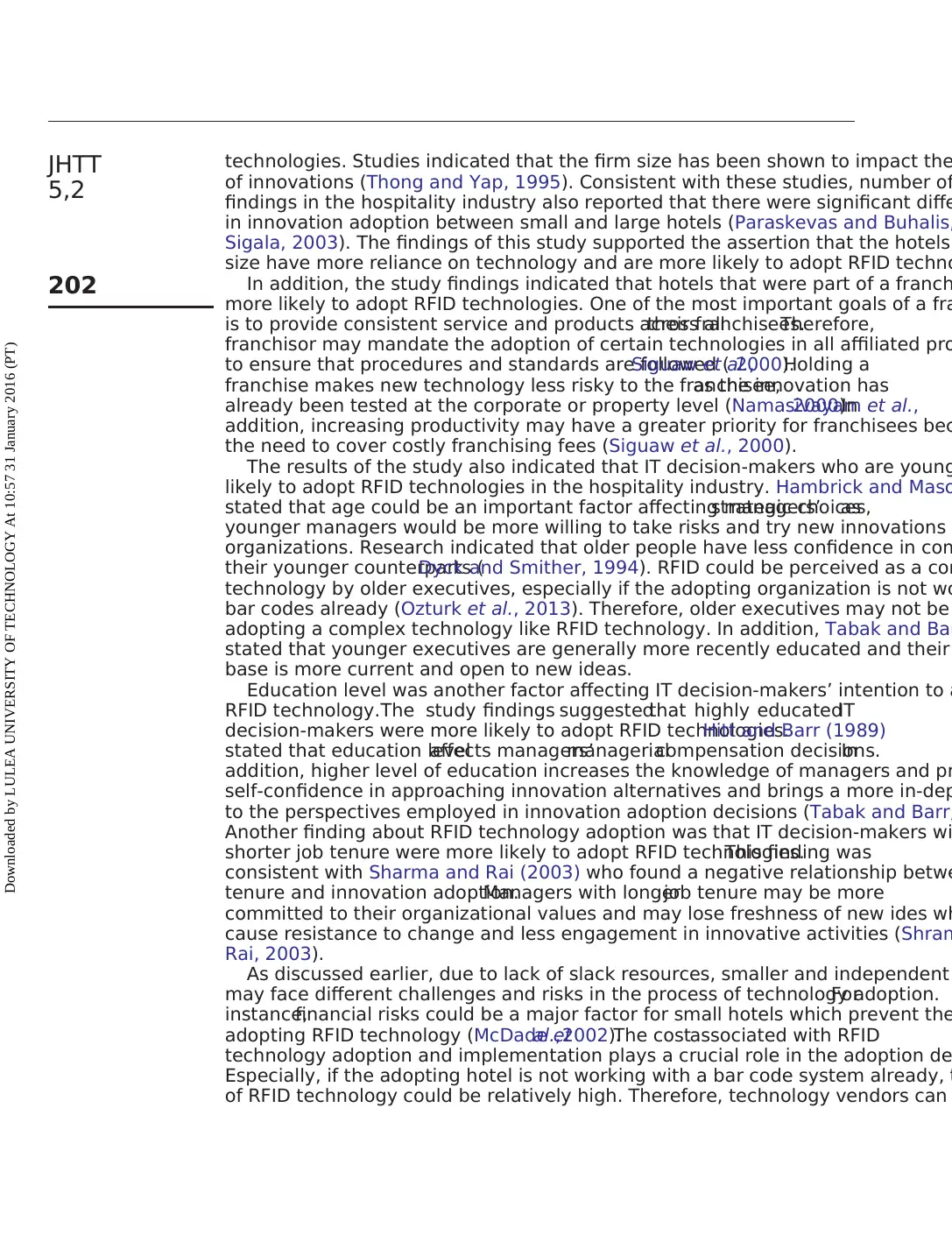
technologies. Studies indicated that the firm size has been shown to impact the
of innovations (Thong and Yap, 1995). Consistent with these studies, number of
findings in the hospitality industry also reported that there were significant diffe
in innovation adoption between small and large hotels (Paraskevas and Buhalis,
Sigala, 2003). The findings of this study supported the assertion that the hotels
size have more reliance on technology and are more likely to adopt RFID techno
In addition, the study findings indicated that hotels that were part of a franch
more likely to adopt RFID technologies. One of the most important goals of a fra
is to provide consistent service and products across alltheir franchisees.Therefore,
franchisor may mandate the adoption of certain technologies in all affiliated pro
to ensure that procedures and standards are followed (Siguaw et al.,2000).Holding a
franchise makes new technology less risky to the franchisee,as the innovation has
already been tested at the corporate or property level (Namasivayam et al.,2000).In
addition, increasing productivity may have a greater priority for franchisees bec
the need to cover costly franchising fees (Siguaw et al., 2000).
The results of the study also indicated that IT decision-makers who are young
likely to adopt RFID technologies in the hospitality industry. Hambrick and Maso
stated that age could be an important factor affecting managers’strategic choices,as
younger managers would be more willing to take risks and try new innovations
organizations. Research indicated that older people have less confidence in com
their younger counterparts (Dyck and Smither, 1994). RFID could be perceived as a com
technology by older executives, especially if the adopting organization is not wo
bar codes already (Ozturk et al., 2013). Therefore, older executives may not be
adopting a complex technology like RFID technology. In addition, Tabak and Bar
stated that younger executives are generally more recently educated and their
base is more current and open to new ideas.
Education level was another factor affecting IT decision-makers’ intention to a
RFID technology.The study findings suggestedthat highly educatedIT
decision-makers were more likely to adopt RFID technologies.Hitt and Barr (1989)
stated that education levelaffects managers’managerialcompensation decisions.In
addition, higher level of education increases the knowledge of managers and pr
self-confidence in approaching innovation alternatives and brings a more in-dep
to the perspectives employed in innovation adoption decisions (Tabak and Barr,
Another finding about RFID technology adoption was that IT decision-makers wi
shorter job tenure were more likely to adopt RFID technologies.This finding was
consistent with Sharma and Rai (2003) who found a negative relationship betwe
tenure and innovation adoption.Managers with longerjob tenure may be more
committed to their organizational values and may lose freshness of new ides wh
cause resistance to change and less engagement in innovative activities (Shram
Rai, 2003).
As discussed earlier, due to lack of slack resources, smaller and independent
may face different challenges and risks in the process of technology adoption.For
instance,financial risks could be a major factor for small hotels which prevent the
adopting RFID technology (McDade etal.,2002).The costassociated with RFID
technology adoption and implementation plays a crucial role in the adoption de
Especially, if the adopting hotel is not working with a bar code system already, t
of RFID technology could be relatively high. Therefore, technology vendors can
JHTT
5,2
202
Downloaded by LULEA UNIVERSITY OF TECHNOLOGY At 10:57 31 January 2016 (PT)
of innovations (Thong and Yap, 1995). Consistent with these studies, number of
findings in the hospitality industry also reported that there were significant diffe
in innovation adoption between small and large hotels (Paraskevas and Buhalis,
Sigala, 2003). The findings of this study supported the assertion that the hotels
size have more reliance on technology and are more likely to adopt RFID techno
In addition, the study findings indicated that hotels that were part of a franch
more likely to adopt RFID technologies. One of the most important goals of a fra
is to provide consistent service and products across alltheir franchisees.Therefore,
franchisor may mandate the adoption of certain technologies in all affiliated pro
to ensure that procedures and standards are followed (Siguaw et al.,2000).Holding a
franchise makes new technology less risky to the franchisee,as the innovation has
already been tested at the corporate or property level (Namasivayam et al.,2000).In
addition, increasing productivity may have a greater priority for franchisees bec
the need to cover costly franchising fees (Siguaw et al., 2000).
The results of the study also indicated that IT decision-makers who are young
likely to adopt RFID technologies in the hospitality industry. Hambrick and Maso
stated that age could be an important factor affecting managers’strategic choices,as
younger managers would be more willing to take risks and try new innovations
organizations. Research indicated that older people have less confidence in com
their younger counterparts (Dyck and Smither, 1994). RFID could be perceived as a com
technology by older executives, especially if the adopting organization is not wo
bar codes already (Ozturk et al., 2013). Therefore, older executives may not be
adopting a complex technology like RFID technology. In addition, Tabak and Bar
stated that younger executives are generally more recently educated and their
base is more current and open to new ideas.
Education level was another factor affecting IT decision-makers’ intention to a
RFID technology.The study findings suggestedthat highly educatedIT
decision-makers were more likely to adopt RFID technologies.Hitt and Barr (1989)
stated that education levelaffects managers’managerialcompensation decisions.In
addition, higher level of education increases the knowledge of managers and pr
self-confidence in approaching innovation alternatives and brings a more in-dep
to the perspectives employed in innovation adoption decisions (Tabak and Barr,
Another finding about RFID technology adoption was that IT decision-makers wi
shorter job tenure were more likely to adopt RFID technologies.This finding was
consistent with Sharma and Rai (2003) who found a negative relationship betwe
tenure and innovation adoption.Managers with longerjob tenure may be more
committed to their organizational values and may lose freshness of new ides wh
cause resistance to change and less engagement in innovative activities (Shram
Rai, 2003).
As discussed earlier, due to lack of slack resources, smaller and independent
may face different challenges and risks in the process of technology adoption.For
instance,financial risks could be a major factor for small hotels which prevent the
adopting RFID technology (McDade etal.,2002).The costassociated with RFID
technology adoption and implementation plays a crucial role in the adoption de
Especially, if the adopting hotel is not working with a bar code system already, t
of RFID technology could be relatively high. Therefore, technology vendors can
JHTT
5,2
202
Downloaded by LULEA UNIVERSITY OF TECHNOLOGY At 10:57 31 January 2016 (PT)
Secure Best Marks with AI Grader
Need help grading? Try our AI Grader for instant feedback on your assignments.
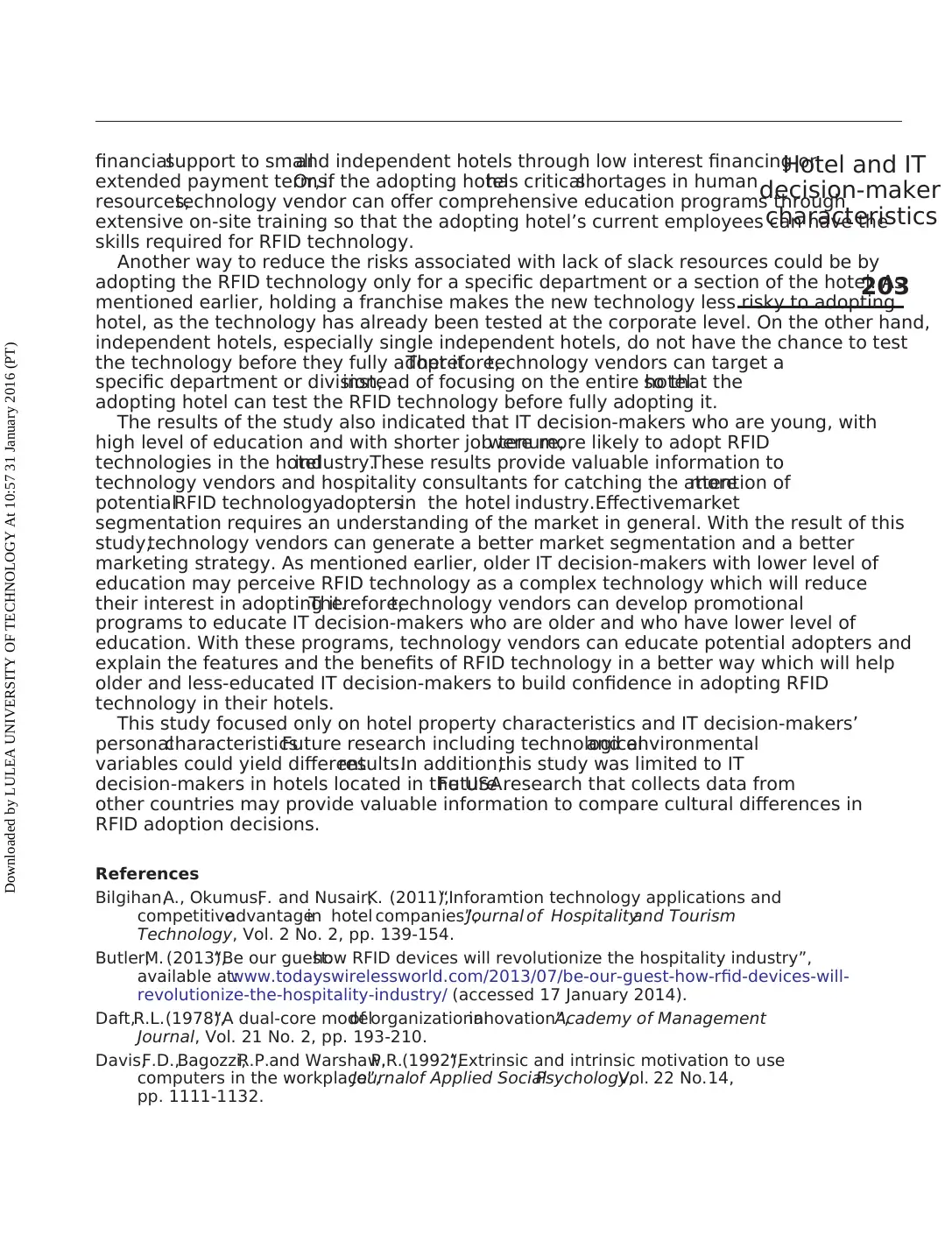
financialsupport to smalland independent hotels through low interest financing or
extended payment terms.Or, if the adopting hotelhas criticalshortages in human
resources,technology vendor can offer comprehensive education programs through
extensive on-site training so that the adopting hotel’s current employees can have the
skills required for RFID technology.
Another way to reduce the risks associated with lack of slack resources could be by
adopting the RFID technology only for a specific department or a section of the hotel. As
mentioned earlier, holding a franchise makes the new technology less risky to adopting
hotel, as the technology has already been tested at the corporate level. On the other hand,
independent hotels, especially single independent hotels, do not have the chance to test
the technology before they fully adopt it.Therefore,technology vendors can target a
specific department or division,instead of focusing on the entire hotelso that the
adopting hotel can test the RFID technology before fully adopting it.
The results of the study also indicated that IT decision-makers who are young, with
high level of education and with shorter job tenure,were more likely to adopt RFID
technologies in the hotelindustry.These results provide valuable information to
technology vendors and hospitality consultants for catching the attention ofmore
potentialRFID technologyadoptersin the hotel industry.Effectivemarket
segmentation requires an understanding of the market in general. With the result of this
study,technology vendors can generate a better market segmentation and a better
marketing strategy. As mentioned earlier, older IT decision-makers with lower level of
education may perceive RFID technology as a complex technology which will reduce
their interest in adopting it.Therefore,technology vendors can develop promotional
programs to educate IT decision-makers who are older and who have lower level of
education. With these programs, technology vendors can educate potential adopters and
explain the features and the benefits of RFID technology in a better way which will help
older and less-educated IT decision-makers to build confidence in adopting RFID
technology in their hotels.
This study focused only on hotel property characteristics and IT decision-makers’
personalcharacteristics.Future research including technologicaland environmental
variables could yield differentresults.In addition,this study was limited to IT
decision-makers in hotels located in the USA.Future research that collects data from
other countries may provide valuable information to compare cultural differences in
RFID adoption decisions.
References
Bilgihan,A., Okumus,F. and Nusair,K. (2011),“Inforamtion technology applications and
competitiveadvantagein hotel companies”,Journal of Hospitalityand Tourism
Technology, Vol. 2 No. 2, pp. 139-154.
Butler,M. (2013),“Be our guest:how RFID devices will revolutionize the hospitality industry”,
available at:www.todayswirelessworld.com/2013/07/be-our-guest-how-rfid-devices-will-
revolutionize-the-hospitality-industry/ (accessed 17 January 2014).
Daft,R.L.(1978),“A dual-core modelof organizationalinnovation”,Academy of Management
Journal, Vol. 21 No. 2, pp. 193-210.
Davis,F.D.,Bagozzi,R.P.and Warshaw,P.R.(1992),“Extrinsic and intrinsic motivation to use
computers in the workplace”,Journalof Applied SocialPsychology,Vol. 22 No.14,
pp. 1111-1132.
203
Hotel and IT
decision-maker
characteristics
Downloaded by LULEA UNIVERSITY OF TECHNOLOGY At 10:57 31 January 2016 (PT)
extended payment terms.Or, if the adopting hotelhas criticalshortages in human
resources,technology vendor can offer comprehensive education programs through
extensive on-site training so that the adopting hotel’s current employees can have the
skills required for RFID technology.
Another way to reduce the risks associated with lack of slack resources could be by
adopting the RFID technology only for a specific department or a section of the hotel. As
mentioned earlier, holding a franchise makes the new technology less risky to adopting
hotel, as the technology has already been tested at the corporate level. On the other hand,
independent hotels, especially single independent hotels, do not have the chance to test
the technology before they fully adopt it.Therefore,technology vendors can target a
specific department or division,instead of focusing on the entire hotelso that the
adopting hotel can test the RFID technology before fully adopting it.
The results of the study also indicated that IT decision-makers who are young, with
high level of education and with shorter job tenure,were more likely to adopt RFID
technologies in the hotelindustry.These results provide valuable information to
technology vendors and hospitality consultants for catching the attention ofmore
potentialRFID technologyadoptersin the hotel industry.Effectivemarket
segmentation requires an understanding of the market in general. With the result of this
study,technology vendors can generate a better market segmentation and a better
marketing strategy. As mentioned earlier, older IT decision-makers with lower level of
education may perceive RFID technology as a complex technology which will reduce
their interest in adopting it.Therefore,technology vendors can develop promotional
programs to educate IT decision-makers who are older and who have lower level of
education. With these programs, technology vendors can educate potential adopters and
explain the features and the benefits of RFID technology in a better way which will help
older and less-educated IT decision-makers to build confidence in adopting RFID
technology in their hotels.
This study focused only on hotel property characteristics and IT decision-makers’
personalcharacteristics.Future research including technologicaland environmental
variables could yield differentresults.In addition,this study was limited to IT
decision-makers in hotels located in the USA.Future research that collects data from
other countries may provide valuable information to compare cultural differences in
RFID adoption decisions.
References
Bilgihan,A., Okumus,F. and Nusair,K. (2011),“Inforamtion technology applications and
competitiveadvantagein hotel companies”,Journal of Hospitalityand Tourism
Technology, Vol. 2 No. 2, pp. 139-154.
Butler,M. (2013),“Be our guest:how RFID devices will revolutionize the hospitality industry”,
available at:www.todayswirelessworld.com/2013/07/be-our-guest-how-rfid-devices-will-
revolutionize-the-hospitality-industry/ (accessed 17 January 2014).
Daft,R.L.(1978),“A dual-core modelof organizationalinnovation”,Academy of Management
Journal, Vol. 21 No. 2, pp. 193-210.
Davis,F.D.,Bagozzi,R.P.and Warshaw,P.R.(1992),“Extrinsic and intrinsic motivation to use
computers in the workplace”,Journalof Applied SocialPsychology,Vol. 22 No.14,
pp. 1111-1132.
203
Hotel and IT
decision-maker
characteristics
Downloaded by LULEA UNIVERSITY OF TECHNOLOGY At 10:57 31 January 2016 (PT)
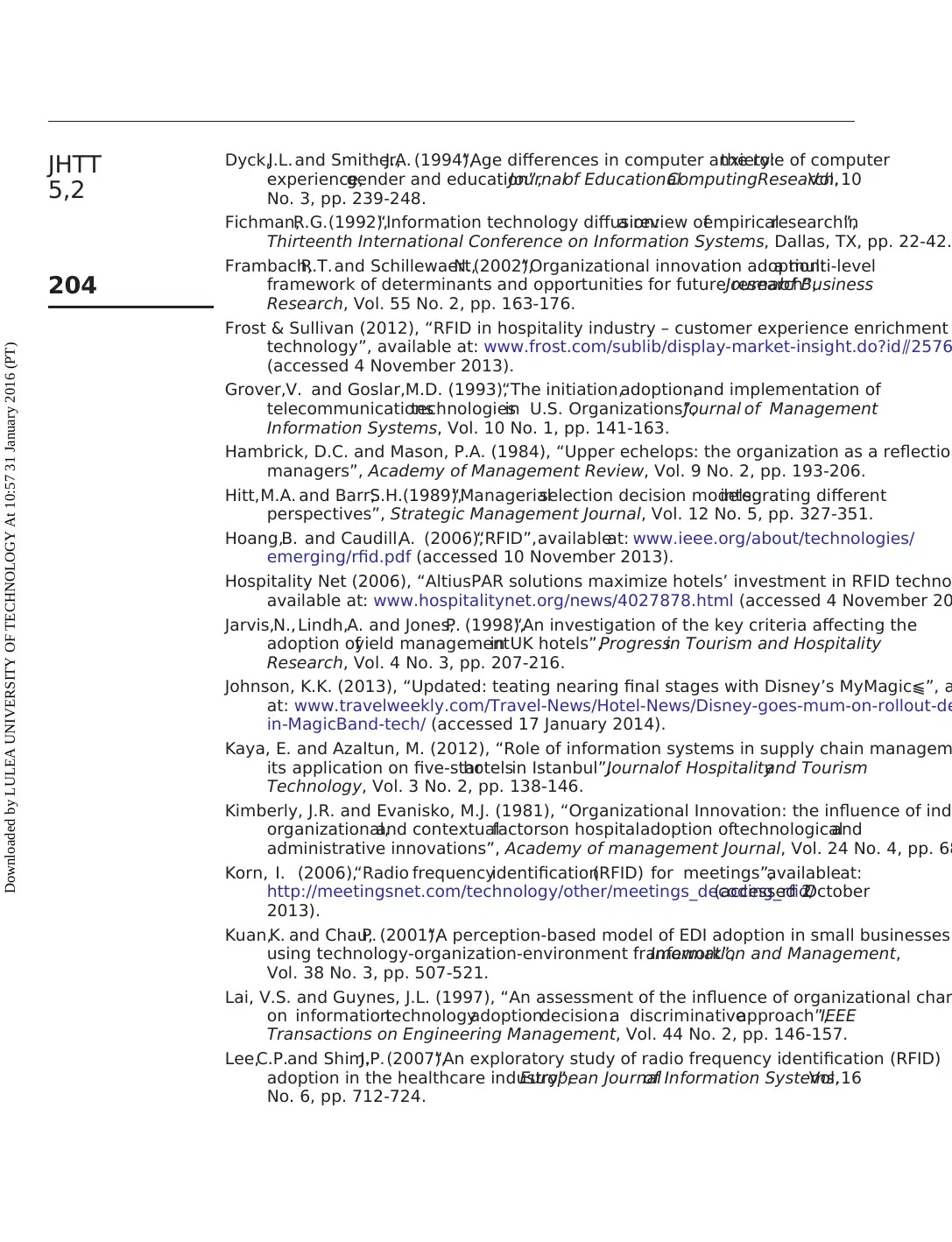
Dyck,J.L. and Smither,J.A. (1994),“Age differences in computer anxiety:the role of computer
experience,gender and education”,Journalof EducationalComputingResearch,Vol. 10
No. 3, pp. 239-248.
Fichman,R.G.(1992),“Information technology diffusion:a review ofempiricalresearch”,in
Thirteenth International Conference on Information Systems, Dallas, TX, pp. 22-42.
Frambach,R.T.and Schillewaert,N. (2002),“Organizational innovation adoption:a multi-level
framework of determinants and opportunities for future research”,Journalof Business
Research, Vol. 55 No. 2, pp. 163-176.
Frost & Sullivan (2012), “RFID in hospitality industry – customer experience enrichment
technology”, available at: www.frost.com/sublib/display-market-insight.do?id⫽2576
(accessed 4 November 2013).
Grover,V. and Goslar,M.D. (1993),“The initiation,adoption,and implementation of
telecommunicationstechnologiesin U.S. Organizations”,Journal of Management
Information Systems, Vol. 10 No. 1, pp. 141-163.
Hambrick, D.C. and Mason, P.A. (1984), “Upper echelops: the organization as a reflection
managers”, Academy of Management Review, Vol. 9 No. 2, pp. 193-206.
Hitt,M.A. and Barr,S.H.(1989),“Managerialselection decision models:integrating different
perspectives”, Strategic Management Journal, Vol. 12 No. 5, pp. 327-351.
Hoang,B. and Caudill,A. (2006),“RFID”,availableat: www.ieee.org/about/technologies/
emerging/rfid.pdf (accessed 10 November 2013).
Hospitality Net (2006), “AltiusPAR solutions maximize hotels’ investment in RFID techno
available at: www.hospitalitynet.org/news/4027878.html (accessed 4 November 20
Jarvis,N., Lindh,A. and Jones,P. (1998),“An investigation of the key criteria affecting the
adoption ofyield managementin UK hotels”,Progressin Tourism and Hospitality
Research, Vol. 4 No. 3, pp. 207-216.
Johnson, K.K. (2013), “Updated: teating nearing final stages with Disney’s MyMagic⫹”, a
at: www.travelweekly.com/Travel-News/Hotel-News/Disney-goes-mum-on-rollout-de
in-MagicBand-tech/ (accessed 17 January 2014).
Kaya, E. and Azaltun, M. (2012), “Role of information systems in supply chain managem
its application on five-starhotelsin Istanbul”,Journalof Hospitalityand Tourism
Technology, Vol. 3 No. 2, pp. 138-146.
Kimberly, J.R. and Evanisko, M.J. (1981), “Organizational Innovation: the influence of ind
organizational,and contextualfactorson hospitaladoption oftechnologicaland
administrative innovations”, Academy of management Journal, Vol. 24 No. 4, pp. 68
Korn, I. (2006),“Radio frequencyidentification(RFID) for meetings”,availableat:
http://meetingsnet.com/technology/other/meetings_decoding_rfid/(accessed 2October
2013).
Kuan,K. and Chau,P. (2001),“A perception-based model of EDI adoption in small businesses
using technology-organization-environment framework”,Information and Management,
Vol. 38 No. 3, pp. 507-521.
Lai, V.S. and Guynes, J.L. (1997), “An assessment of the influence of organizational char
on informationtechnologyadoptiondecision:a discriminativeapproach”,IEEE
Transactions on Engineering Management, Vol. 44 No. 2, pp. 146-157.
Lee,C.P.and Shim,J.P.(2007),“An exploratory study of radio frequency identification (RFID)
adoption in the healthcare industry”,European Journalof Information Systems,Vol.16
No. 6, pp. 712-724.
JHTT
5,2
204
Downloaded by LULEA UNIVERSITY OF TECHNOLOGY At 10:57 31 January 2016 (PT)
experience,gender and education”,Journalof EducationalComputingResearch,Vol. 10
No. 3, pp. 239-248.
Fichman,R.G.(1992),“Information technology diffusion:a review ofempiricalresearch”,in
Thirteenth International Conference on Information Systems, Dallas, TX, pp. 22-42.
Frambach,R.T.and Schillewaert,N. (2002),“Organizational innovation adoption:a multi-level
framework of determinants and opportunities for future research”,Journalof Business
Research, Vol. 55 No. 2, pp. 163-176.
Frost & Sullivan (2012), “RFID in hospitality industry – customer experience enrichment
technology”, available at: www.frost.com/sublib/display-market-insight.do?id⫽2576
(accessed 4 November 2013).
Grover,V. and Goslar,M.D. (1993),“The initiation,adoption,and implementation of
telecommunicationstechnologiesin U.S. Organizations”,Journal of Management
Information Systems, Vol. 10 No. 1, pp. 141-163.
Hambrick, D.C. and Mason, P.A. (1984), “Upper echelops: the organization as a reflection
managers”, Academy of Management Review, Vol. 9 No. 2, pp. 193-206.
Hitt,M.A. and Barr,S.H.(1989),“Managerialselection decision models:integrating different
perspectives”, Strategic Management Journal, Vol. 12 No. 5, pp. 327-351.
Hoang,B. and Caudill,A. (2006),“RFID”,availableat: www.ieee.org/about/technologies/
emerging/rfid.pdf (accessed 10 November 2013).
Hospitality Net (2006), “AltiusPAR solutions maximize hotels’ investment in RFID techno
available at: www.hospitalitynet.org/news/4027878.html (accessed 4 November 20
Jarvis,N., Lindh,A. and Jones,P. (1998),“An investigation of the key criteria affecting the
adoption ofyield managementin UK hotels”,Progressin Tourism and Hospitality
Research, Vol. 4 No. 3, pp. 207-216.
Johnson, K.K. (2013), “Updated: teating nearing final stages with Disney’s MyMagic⫹”, a
at: www.travelweekly.com/Travel-News/Hotel-News/Disney-goes-mum-on-rollout-de
in-MagicBand-tech/ (accessed 17 January 2014).
Kaya, E. and Azaltun, M. (2012), “Role of information systems in supply chain managem
its application on five-starhotelsin Istanbul”,Journalof Hospitalityand Tourism
Technology, Vol. 3 No. 2, pp. 138-146.
Kimberly, J.R. and Evanisko, M.J. (1981), “Organizational Innovation: the influence of ind
organizational,and contextualfactorson hospitaladoption oftechnologicaland
administrative innovations”, Academy of management Journal, Vol. 24 No. 4, pp. 68
Korn, I. (2006),“Radio frequencyidentification(RFID) for meetings”,availableat:
http://meetingsnet.com/technology/other/meetings_decoding_rfid/(accessed 2October
2013).
Kuan,K. and Chau,P. (2001),“A perception-based model of EDI adoption in small businesses
using technology-organization-environment framework”,Information and Management,
Vol. 38 No. 3, pp. 507-521.
Lai, V.S. and Guynes, J.L. (1997), “An assessment of the influence of organizational char
on informationtechnologyadoptiondecision:a discriminativeapproach”,IEEE
Transactions on Engineering Management, Vol. 44 No. 2, pp. 146-157.
Lee,C.P.and Shim,J.P.(2007),“An exploratory study of radio frequency identification (RFID)
adoption in the healthcare industry”,European Journalof Information Systems,Vol.16
No. 6, pp. 712-724.
JHTT
5,2
204
Downloaded by LULEA UNIVERSITY OF TECHNOLOGY At 10:57 31 January 2016 (PT)
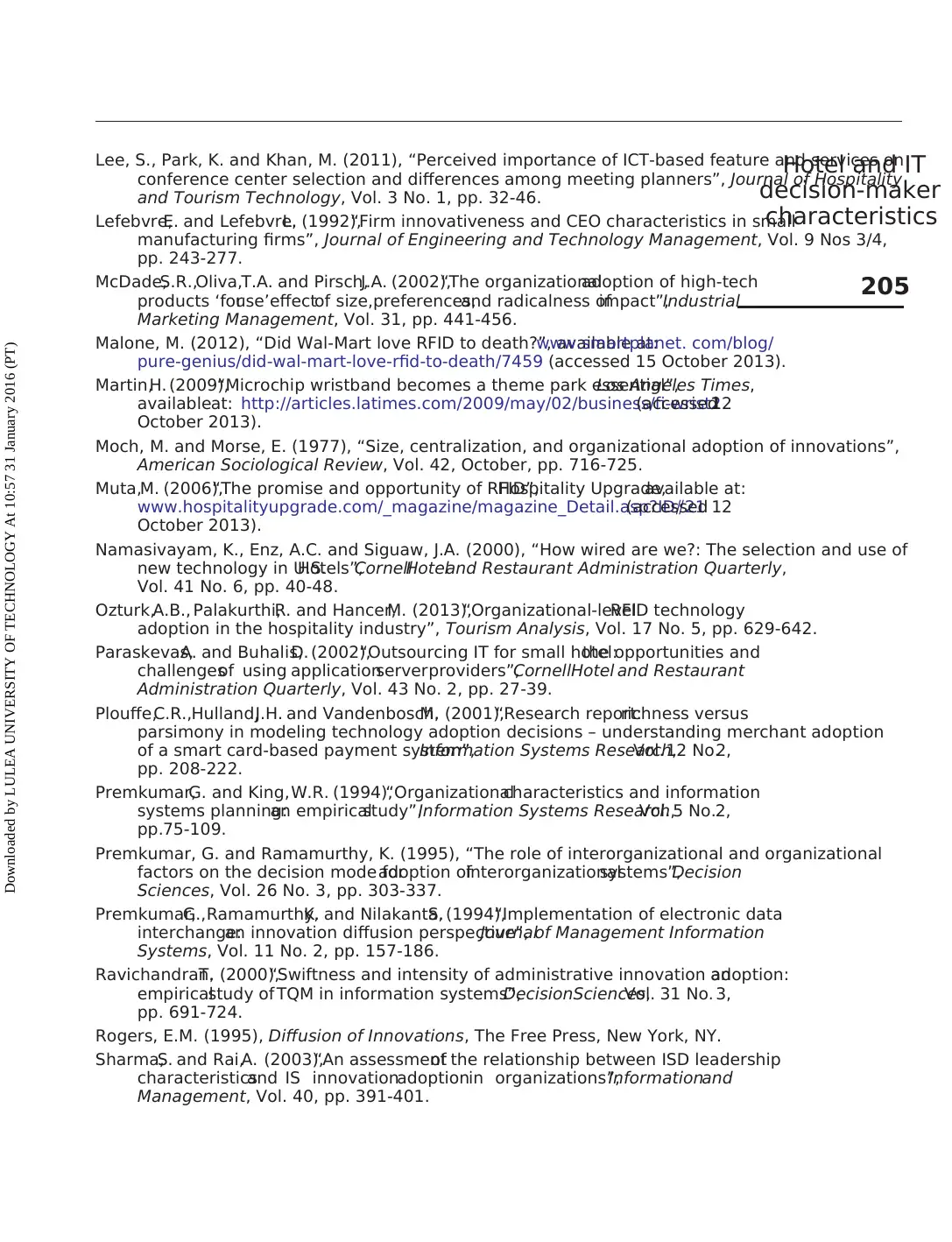
Lee, S., Park, K. and Khan, M. (2011), “Perceived importance of ICT-based feature and services on
conference center selection and differences among meeting planners”, Journal of Hospitality
and Tourism Technology, Vol. 3 No. 1, pp. 32-46.
Lefebvre,E. and Lefebvre,L. (1992),“Firm innovativeness and CEO characteristics in small
manufacturing firms”, Journal of Engineering and Technology Management, Vol. 9 Nos 3/4,
pp. 243-277.
McDade,S.R.,Oliva,T.A. and Pirsch,J.A. (2002),“The organizationaladoption of high-tech
products ‘foruse’effectof size,preferences,and radicalness ofimpact”,Industrial
Marketing Management, Vol. 31, pp. 441-456.
Malone, M. (2012), “Did Wal-Mart love RFID to death?”, available at:www.smartplanet. com/blog/
pure-genius/did-wal-mart-love-rfid-to-death/7459 (accessed 15 October 2013).
Martin,H. (2009),“Microchip wristband becomes a theme park essential”,Los Angeles Times,
availableat: http://articles.latimes.com/2009/may/02/business/fi-wrist2(accessed12
October 2013).
Moch, M. and Morse, E. (1977), “Size, centralization, and organizational adoption of innovations”,
American Sociological Review, Vol. 42, October, pp. 716-725.
Muta,M. (2006),“The promise and opportunity of RFID”,Hospitality Upgrade,available at:
www.hospitalityupgrade.com/_magazine/magazine_Detail.asp?ID⫽21(accessed 12
October 2013).
Namasivayam, K., Enz, A.C. and Siguaw, J.A. (2000), “How wired are we?: The selection and use of
new technology in U.S.Hotels”,CornellHoteland Restaurant Administration Quarterly,
Vol. 41 No. 6, pp. 40-48.
Ozturk,A.B., Palakurthi,R. and Hancer,M. (2013),“Organizational-levelRFID technology
adoption in the hospitality industry”, Tourism Analysis, Vol. 17 No. 5, pp. 629-642.
Paraskevas,A. and Buhalis,D. (2002),“Outsourcing IT for small hotel:the opportunities and
challengesof using applicationserverproviders”,CornellHotel and Restaurant
Administration Quarterly, Vol. 43 No. 2, pp. 27-39.
Plouffe,C.R.,Hulland,J.H. and Vandenbosch,M. (2001),“Research report:richness versus
parsimony in modeling technology adoption decisions – understanding merchant adoption
of a smart card-based payment system”,Information Systems Research,Vol.12 No.2,
pp. 208-222.
Premkumar,G. and King,W.R. (1994),“Organizationalcharacteristics and information
systems planning:an empiricalstudy”,Information Systems Research,Vol. 5 No.2,
pp.75-109.
Premkumar, G. and Ramamurthy, K. (1995), “The role of interorganizational and organizational
factors on the decision mode foradoption ofinterorganizationalsystems”,Decision
Sciences, Vol. 26 No. 3, pp. 303-337.
Premkumar,G.,Ramamurthy,K. and Nilakanta,S. (1994),“Implementation of electronic data
interchange:an innovation diffusion perspective”,Journalof Management Information
Systems, Vol. 11 No. 2, pp. 157-186.
Ravichandran,T. (2000),“Swiftness and intensity of administrative innovation adoption:an
empiricalstudy of TQM in information systems”,DecisionSciences,Vol. 31 No. 3,
pp. 691-724.
Rogers, E.M. (1995), Diffusion of Innovations, The Free Press, New York, NY.
Sharma,S. and Rai,A. (2003),“An assessmentof the relationship between ISD leadership
characteristicsand IS innovationadoptionin organizations”,Informationand
Management, Vol. 40, pp. 391-401.
205
Hotel and IT
decision-maker
characteristics
Downloaded by LULEA UNIVERSITY OF TECHNOLOGY At 10:57 31 January 2016 (PT)
conference center selection and differences among meeting planners”, Journal of Hospitality
and Tourism Technology, Vol. 3 No. 1, pp. 32-46.
Lefebvre,E. and Lefebvre,L. (1992),“Firm innovativeness and CEO characteristics in small
manufacturing firms”, Journal of Engineering and Technology Management, Vol. 9 Nos 3/4,
pp. 243-277.
McDade,S.R.,Oliva,T.A. and Pirsch,J.A. (2002),“The organizationaladoption of high-tech
products ‘foruse’effectof size,preferences,and radicalness ofimpact”,Industrial
Marketing Management, Vol. 31, pp. 441-456.
Malone, M. (2012), “Did Wal-Mart love RFID to death?”, available at:www.smartplanet. com/blog/
pure-genius/did-wal-mart-love-rfid-to-death/7459 (accessed 15 October 2013).
Martin,H. (2009),“Microchip wristband becomes a theme park essential”,Los Angeles Times,
availableat: http://articles.latimes.com/2009/may/02/business/fi-wrist2(accessed12
October 2013).
Moch, M. and Morse, E. (1977), “Size, centralization, and organizational adoption of innovations”,
American Sociological Review, Vol. 42, October, pp. 716-725.
Muta,M. (2006),“The promise and opportunity of RFID”,Hospitality Upgrade,available at:
www.hospitalityupgrade.com/_magazine/magazine_Detail.asp?ID⫽21(accessed 12
October 2013).
Namasivayam, K., Enz, A.C. and Siguaw, J.A. (2000), “How wired are we?: The selection and use of
new technology in U.S.Hotels”,CornellHoteland Restaurant Administration Quarterly,
Vol. 41 No. 6, pp. 40-48.
Ozturk,A.B., Palakurthi,R. and Hancer,M. (2013),“Organizational-levelRFID technology
adoption in the hospitality industry”, Tourism Analysis, Vol. 17 No. 5, pp. 629-642.
Paraskevas,A. and Buhalis,D. (2002),“Outsourcing IT for small hotel:the opportunities and
challengesof using applicationserverproviders”,CornellHotel and Restaurant
Administration Quarterly, Vol. 43 No. 2, pp. 27-39.
Plouffe,C.R.,Hulland,J.H. and Vandenbosch,M. (2001),“Research report:richness versus
parsimony in modeling technology adoption decisions – understanding merchant adoption
of a smart card-based payment system”,Information Systems Research,Vol.12 No.2,
pp. 208-222.
Premkumar,G. and King,W.R. (1994),“Organizationalcharacteristics and information
systems planning:an empiricalstudy”,Information Systems Research,Vol. 5 No.2,
pp.75-109.
Premkumar, G. and Ramamurthy, K. (1995), “The role of interorganizational and organizational
factors on the decision mode foradoption ofinterorganizationalsystems”,Decision
Sciences, Vol. 26 No. 3, pp. 303-337.
Premkumar,G.,Ramamurthy,K. and Nilakanta,S. (1994),“Implementation of electronic data
interchange:an innovation diffusion perspective”,Journalof Management Information
Systems, Vol. 11 No. 2, pp. 157-186.
Ravichandran,T. (2000),“Swiftness and intensity of administrative innovation adoption:an
empiricalstudy of TQM in information systems”,DecisionSciences,Vol. 31 No. 3,
pp. 691-724.
Rogers, E.M. (1995), Diffusion of Innovations, The Free Press, New York, NY.
Sharma,S. and Rai,A. (2003),“An assessmentof the relationship between ISD leadership
characteristicsand IS innovationadoptionin organizations”,Informationand
Management, Vol. 40, pp. 391-401.
205
Hotel and IT
decision-maker
characteristics
Downloaded by LULEA UNIVERSITY OF TECHNOLOGY At 10:57 31 January 2016 (PT)
Paraphrase This Document
Need a fresh take? Get an instant paraphrase of this document with our AI Paraphraser
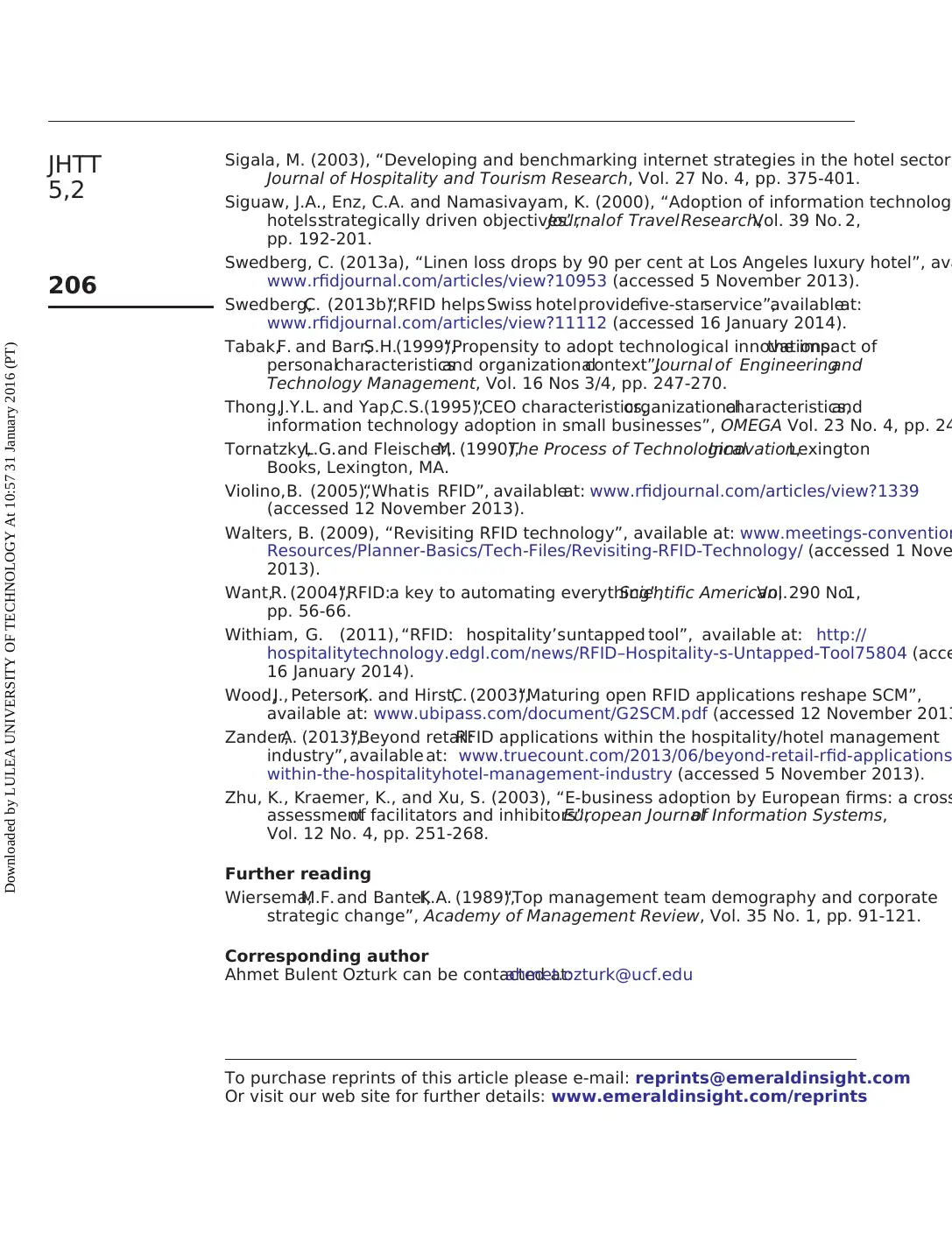
Sigala, M. (2003), “Developing and benchmarking internet strategies in the hotel sector
Journal of Hospitality and Tourism Research, Vol. 27 No. 4, pp. 375-401.
Siguaw, J.A., Enz, C.A. and Namasivayam, K. (2000), “Adoption of information technology
hotels:strategically driven objectives”,Journalof TravelResearch,Vol. 39 No. 2,
pp. 192-201.
Swedberg, C. (2013a), “Linen loss drops by 90 per cent at Los Angeles luxury hotel”, ava
www.rfidjournal.com/articles/view?10953 (accessed 5 November 2013).
Swedberg,C. (2013b),“RFID helpsSwiss hotelprovidefive-starservice”,availableat:
www.rfidjournal.com/articles/view?11112 (accessed 16 January 2014).
Tabak,F. and Barr,S.H.(1999),“Propensity to adopt technological innovations:the impact of
personalcharacteristicsand organizationalcontext”,Journal of Engineeringand
Technology Management, Vol. 16 Nos 3/4, pp. 247-270.
Thong,J.Y.L. and Yap,C.S.(1995),“CEO characteristics,organizationalcharacteristics,and
information technology adoption in small businesses”, OMEGA Vol. 23 No. 4, pp. 24
Tornatzky,L.G.and Fleischer,M. (1990),The Process of TechnologicalInnovation,Lexington
Books, Lexington, MA.
Violino,B. (2005),“Whatis RFID”, availableat: www.rfidjournal.com/articles/view?1339
(accessed 12 November 2013).
Walters, B. (2009), “Revisiting RFID technology”, available at: www.meetings-convention
Resources/Planner-Basics/Tech-Files/Revisiting-RFID-Technology/ (accessed 1 Nove
2013).
Want,R. (2004),“RFID:a key to automating everything”,Scientific American,Vol.290 No.1,
pp. 56-66.
Withiam, G. (2011), “RFID: hospitality’suntapped tool”, available at: http://
hospitalitytechnology.edgl.com/news/RFID–Hospitality-s-Untapped-Tool75804 (acce
16 January 2014).
Wood,J., Peterson,K. and Hirst,C. (2003),“Maturing open RFID applications reshape SCM”,
available at: www.ubipass.com/document/G2SCM.pdf (accessed 12 November 2013
Zander,A. (2013),“Beyond retail:RFID applications within the hospitality/hotel management
industry”,available at: www.truecount.com/2013/06/beyond-retail-rfid-applications
within-the-hospitalityhotel-management-industry (accessed 5 November 2013).
Zhu, K., Kraemer, K., and Xu, S. (2003), “E-business adoption by European firms: a cross
assessmentof facilitators and inhibitors”,European Journalof Information Systems,
Vol. 12 No. 4, pp. 251-268.
Further reading
Wiersema,M.F. and Bantel,K.A. (1989),“Top management team demography and corporate
strategic change”, Academy of Management Review, Vol. 35 No. 1, pp. 91-121.
Corresponding author
Ahmet Bulent Ozturk can be contacted at:ahmet.ozturk@ucf.edu
To purchase reprints of this article please e-mail: reprints@emeraldinsight.com
Or visit our web site for further details: www.emeraldinsight.com/reprints
JHTT
5,2
206
Downloaded by LULEA UNIVERSITY OF TECHNOLOGY At 10:57 31 January 2016 (PT)
Journal of Hospitality and Tourism Research, Vol. 27 No. 4, pp. 375-401.
Siguaw, J.A., Enz, C.A. and Namasivayam, K. (2000), “Adoption of information technology
hotels:strategically driven objectives”,Journalof TravelResearch,Vol. 39 No. 2,
pp. 192-201.
Swedberg, C. (2013a), “Linen loss drops by 90 per cent at Los Angeles luxury hotel”, ava
www.rfidjournal.com/articles/view?10953 (accessed 5 November 2013).
Swedberg,C. (2013b),“RFID helpsSwiss hotelprovidefive-starservice”,availableat:
www.rfidjournal.com/articles/view?11112 (accessed 16 January 2014).
Tabak,F. and Barr,S.H.(1999),“Propensity to adopt technological innovations:the impact of
personalcharacteristicsand organizationalcontext”,Journal of Engineeringand
Technology Management, Vol. 16 Nos 3/4, pp. 247-270.
Thong,J.Y.L. and Yap,C.S.(1995),“CEO characteristics,organizationalcharacteristics,and
information technology adoption in small businesses”, OMEGA Vol. 23 No. 4, pp. 24
Tornatzky,L.G.and Fleischer,M. (1990),The Process of TechnologicalInnovation,Lexington
Books, Lexington, MA.
Violino,B. (2005),“Whatis RFID”, availableat: www.rfidjournal.com/articles/view?1339
(accessed 12 November 2013).
Walters, B. (2009), “Revisiting RFID technology”, available at: www.meetings-convention
Resources/Planner-Basics/Tech-Files/Revisiting-RFID-Technology/ (accessed 1 Nove
2013).
Want,R. (2004),“RFID:a key to automating everything”,Scientific American,Vol.290 No.1,
pp. 56-66.
Withiam, G. (2011), “RFID: hospitality’suntapped tool”, available at: http://
hospitalitytechnology.edgl.com/news/RFID–Hospitality-s-Untapped-Tool75804 (acce
16 January 2014).
Wood,J., Peterson,K. and Hirst,C. (2003),“Maturing open RFID applications reshape SCM”,
available at: www.ubipass.com/document/G2SCM.pdf (accessed 12 November 2013
Zander,A. (2013),“Beyond retail:RFID applications within the hospitality/hotel management
industry”,available at: www.truecount.com/2013/06/beyond-retail-rfid-applications
within-the-hospitalityhotel-management-industry (accessed 5 November 2013).
Zhu, K., Kraemer, K., and Xu, S. (2003), “E-business adoption by European firms: a cross
assessmentof facilitators and inhibitors”,European Journalof Information Systems,
Vol. 12 No. 4, pp. 251-268.
Further reading
Wiersema,M.F. and Bantel,K.A. (1989),“Top management team demography and corporate
strategic change”, Academy of Management Review, Vol. 35 No. 1, pp. 91-121.
Corresponding author
Ahmet Bulent Ozturk can be contacted at:ahmet.ozturk@ucf.edu
To purchase reprints of this article please e-mail: reprints@emeraldinsight.com
Or visit our web site for further details: www.emeraldinsight.com/reprints
JHTT
5,2
206
Downloaded by LULEA UNIVERSITY OF TECHNOLOGY At 10:57 31 January 2016 (PT)
1 out of 14
Related Documents
Your All-in-One AI-Powered Toolkit for Academic Success.
+13062052269
info@desklib.com
Available 24*7 on WhatsApp / Email
![[object Object]](/_next/static/media/star-bottom.7253800d.svg)
Unlock your academic potential
© 2024 | Zucol Services PVT LTD | All rights reserved.



